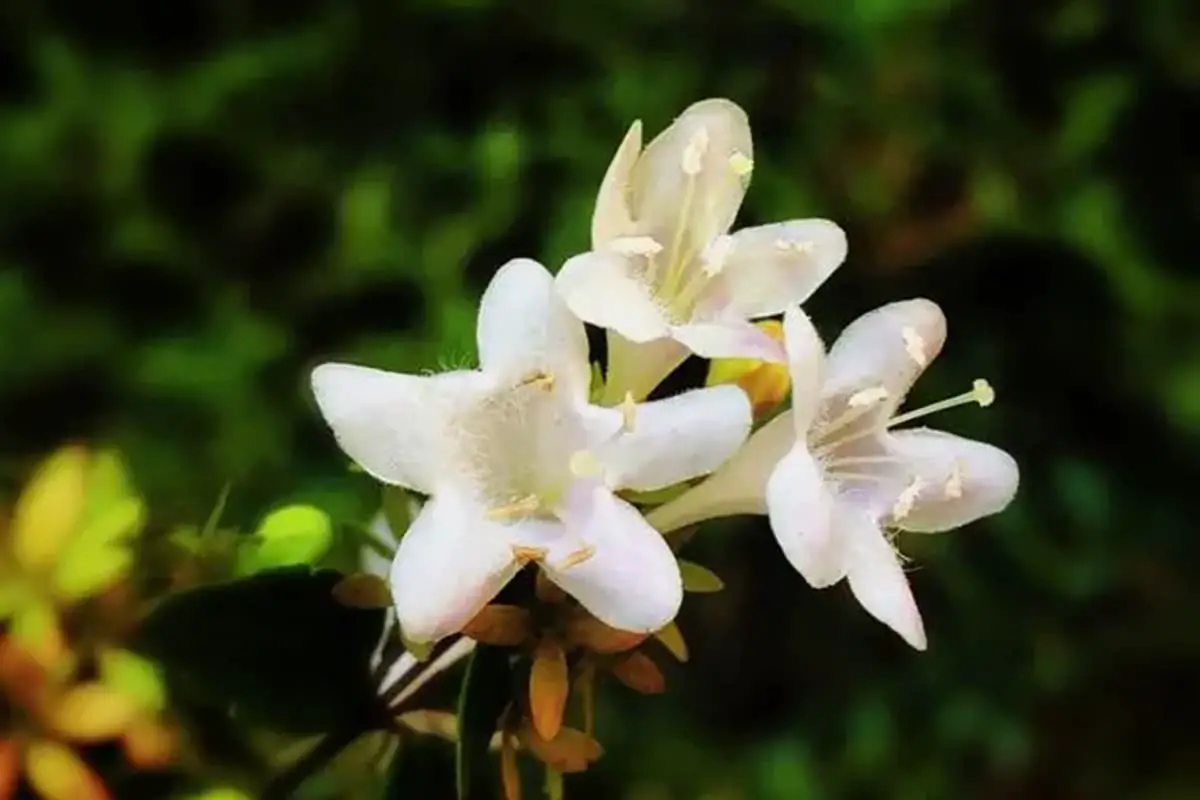
Abelia grandiflora
Abelia grandiflora, commonly known as Glossy Abelia, is a semi-evergreen shrub belonging to the Caprifoliaceae family. This versatile plant is characterized by its arching branches with reddish-brown young stems covered in fine pubescence.
The leaves are opposite, ovate to elliptic, 2-5 cm long, and dark green with a glossy upper surface. The foliage often takes on a purplish tinge in autumn, adding to its ornamental value.
The flowers are tubular to funnel-shaped, approximately 2 cm long, and appear in clusters at the branch tips. They are white with a pale pink blush and have a delicate fragrance. The flowering period is exceptionally long, typically lasting from late spring (May) through late autumn (November). After the flowers fade, the persistent sepals remain, turning a rosy pink and extending the plant’s ornamental interest.
Glossy Abelia is a hybrid resulting from a cross between two Asian species: Abelia chinensis (Chinese Abelia) and Abelia uniflora. This hybridization occurred in Italy in the late 19th century, combining the best traits of both parent species. The resulting plant exhibits larger flowers than A. chinensis and a more robust growth habit than A. uniflora.
Mature plants typically reach a height of 1-1.5 meters with a similar spread, forming a dense, mounded shape. The plant’s graceful, arching habit makes it an excellent choice for borders, hedges, or as a specimen plant.
While not native to Europe as previously stated, Abelia grandiflora has become widely cultivated in temperate regions worldwide. It is indeed found in various parts of China, but as a cultivated ornamental rather than a native species.
Glossy Abelia thrives in full sun to partial shade and is adaptable to a wide range of soil types, including acidic, neutral, and slightly alkaline soils. It prefers well-drained soil but can tolerate brief periods of drought once established. The plant is hardy in USDA zones 6-9, demonstrating good tolerance to both heat and cold.
This shrub is relatively low-maintenance and responds well to pruning, which can be done in late winter or early spring to maintain shape and encourage dense growth. Propagation is typically done through semi-hardwood cuttings taken in summer.
Abelia × grandiflora’s long blooming period, attractive foliage, and adaptable nature make it a valuable addition to many landscape settings. It works well as a foundation planting, in mixed borders, or as a low hedge. The plant also attracts butterflies and other pollinators, adding ecological value to gardens.
In landscaping, Glossy Abelia can be effectively used in various ways:
Its compact form, long-lasting flowers, and adaptability make Abelia × grandiflora a popular choice for both novice and experienced gardeners seeking a reliable and attractive shrub for their landscapes.
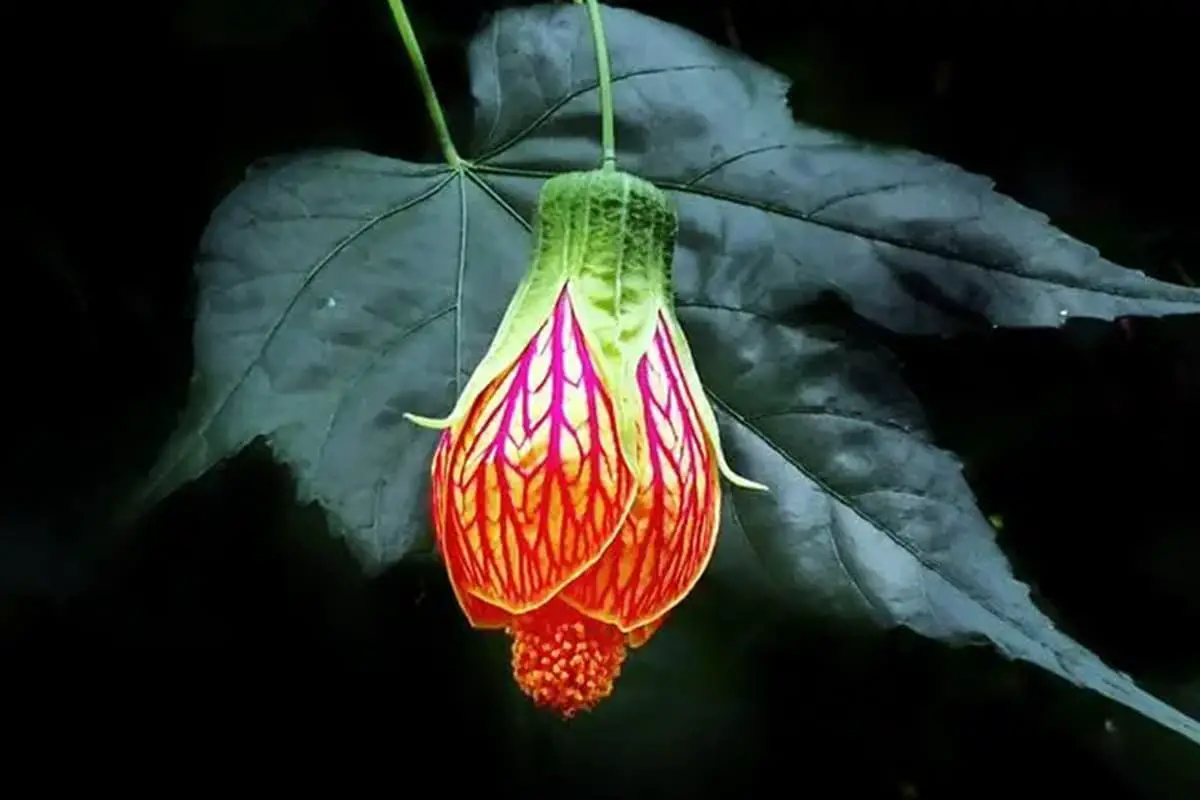
Abutilon pictum: The Flowering Maple
Abutilon pictum, commonly known as the Flowering Maple or Chinese Lantern, is an evergreen shrub belonging to the Malvaceae family. Despite its common name, it is not related to true maples. This ornamental plant typically grows to a height of 1-3 meters (3-10 feet), forming a bushy, upright habit.
Foliage:
The leaves of Abutilon pictum are one of its distinguishing features. They are palmate, with 3-5 ovate, tapering lobes, resembling maple leaves. The leaf margins are serrated or coarsely toothed. The foliage can be either glabrous (smooth) or slightly pubescent with stellate (star-shaped) hairs on both surfaces. Leaf stalks (petioles) measure 3-6 cm in length and are typically glabrous. The stipules are subulate (awl-shaped) and caducous, falling off early in the leaf’s development.
Flowers:
The flowers of Abutilon pictum are truly spectacular, appearing singly in the leaf axils and hanging downwards. They are campanulate (bell-shaped) and typically measure 5-7 cm in diameter. The flower color is a vibrant orange-yellow with distinctive purple or red veining, giving rise to various cultivars with different color combinations. The exterior of the flowers is covered with soft hairs.
The reproductive structures include yellow-brown anthers clustered at the tip of the staminal column. The ovary is obtuse and pubescent, with the style branches ending in capitate stigmas. Flowering occurs from late spring through autumn, typically from May to October, providing a long season of interest.
Native Habitat and Growing Conditions:
Abutilon pictum is native to South America, particularly Brazil and Uruguay. It thrives in warm, humid climates and is not frost-hardy, typically suited to USDA zones 9-11. In its natural habitat, it can be found in forest margins and disturbed areas.
This species prefers full sun to partial shade, with protection from intense afternoon sun in hotter climates. It grows best in fertile, moist, well-drained soils with a slightly acidic to neutral pH (6.1-7.5). While it can tolerate poorer soils, optimal growth and flowering are achieved in rich, organic substrates.
Cultivation and Care:
Propagation of Abutilon pictum is primarily done through semi-hardwood cuttings taken in late summer or early autumn. Seeds can also be used but may not produce plants true to the parent.
In cultivation, regular watering is essential, especially during dry periods, but the soil should not be waterlogged. Fertilize monthly during the growing season with a balanced, water-soluble fertilizer to promote healthy growth and abundant flowering.
Pruning can be done in late winter or early spring to maintain shape and encourage bushiness. Pinching out growing tips will also promote a fuller form.
Ornamental Value and Uses:
Abutilon pictum is highly valued for its ornamental qualities. Its pendulous, lantern-like flowers and attractive foliage make it suitable for various landscape applications. It excels as a container plant on patios or in conservatories, and can be used effectively in mixed borders, as a specimen plant, or trained against a wall or trellis.
In regions with colder winters, such as parts of Jiangsu and Zhejiang provinces in China, winter protection is crucial. In these areas, it’s often grown as a patio plant that can be moved indoors during colder months. When grown indoors, place it in a bright, warm location with high humidity for best results.
Cultivars and Hybrids:
Several cultivars and hybrids of Abutilon pictum have been developed, offering a range of flower colors and variegated foliage. Some popular varieties include:
In conclusion, Abutilon pictum is a versatile and attractive ornamental plant that brings a touch of tropical elegance to gardens and indoor spaces. Its long flowering period, coupled with its relatively easy care requirements, makes it a favorite among gardeners and plant enthusiasts in suitable climates worldwide.
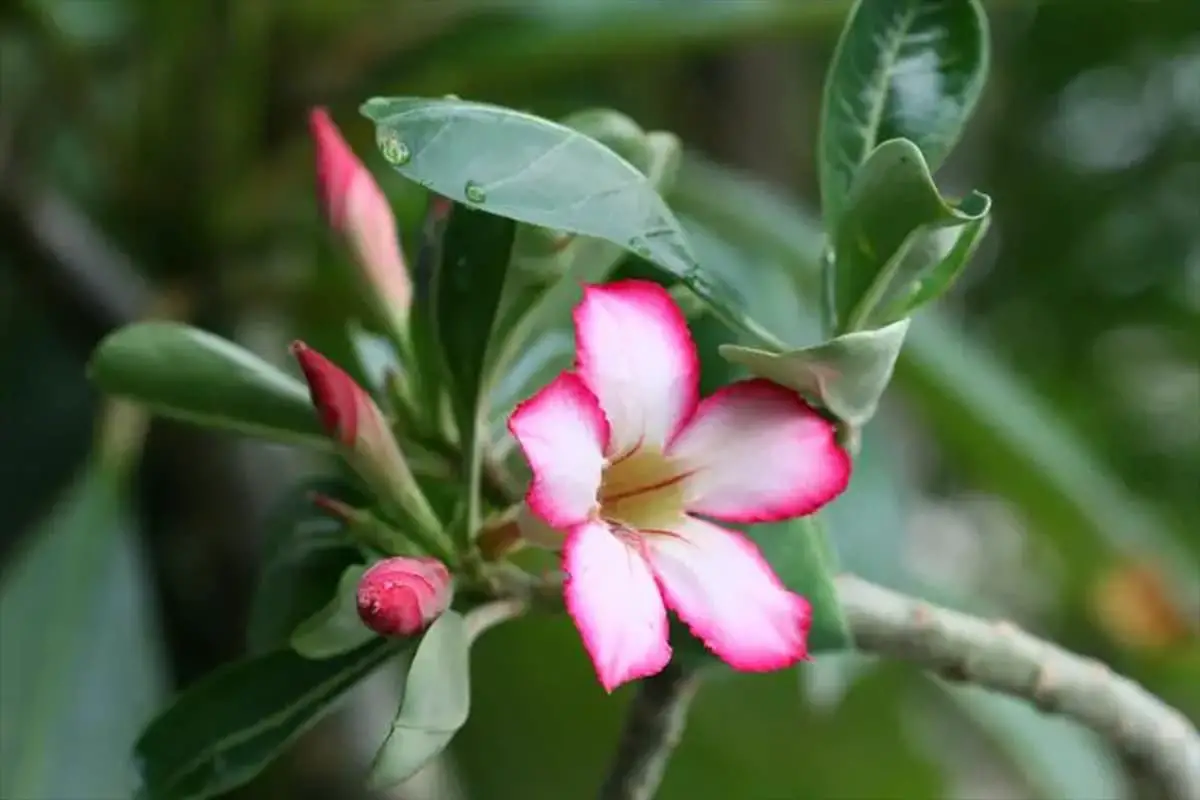
Adenium obesum, commonly known as Desert Rose, is a striking succulent shrub or small tree belonging to the Apocynaceae family. This distinctive plant is characterized by its thick, tuberous stem, which serves as a water storage organ, adapting it to arid environments. The stem, often referred to as a caudex, can develop into interesting sculptural forms, adding to the plant’s ornamental value.
The leaves of Adenium obesum are spirally arranged, typically clustered near the branch tips. They are simple, oblong to spatulate in shape, and dark green in color, with a leathery texture that helps reduce water loss. Contrary to the original description, the leaves do have short petioles, though they may appear sessile.
The flowers are the plant’s crowning glory, emerging in clusters at the branch tips. They are large, funnel-shaped, and typically 5-7 cm in diameter. While the most common color is a vibrant pink with a paler throat, cultivars now offer a range of hues from pure white to deep red. The flowers have a delicate, silky texture and are often described as waxy or porcelain-like in appearance.
Adenium obesum naturally blooms from late spring through summer, with peak flowering often occurring between April and May in its native habitat. However, in cultivation with ideal conditions, it can flower almost year-round in tropical climates. The fruiting period typically follows 2-3 months after flowering, with seed pods maturing from August to September.
Native to sub-Saharan Africa and the Arabian Peninsula, the Desert Rose thrives in semi-arid to arid regions. It’s found naturally in countries including Kenya, Tanzania, Oman, and Yemen. In cultivation, it requires full sun exposure, warm temperatures (ideally above 60°F/15°C), and excellent drainage. While drought-tolerant, it benefits from regular watering during active growth periods, allowing the soil to dry between waterings.
Propagation can be achieved through seeds or stem cuttings. Seed propagation offers genetic diversity but can be challenging due to low germination rates and slow initial growth. Stem cuttings are more commonly used in cultivation, providing faster results and ensuring genetic consistency. Cuttings should be allowed to callus before planting in a well-draining medium.
While Adenium obesum has traditional medicinal uses in its native range, it’s important to note that all parts of the plant contain toxic cardiac glycosides. Therefore, its use as a medicinal plant should be approached with extreme caution and only under expert guidance. In modern horticulture, it’s primarily valued as an ornamental plant.
The Desert Rose has gained popularity worldwide for its unique growth habit, stunning flowers, and adaptability to container culture. It’s particularly suited for bonsai techniques, allowing growers to shape the caudex and branches into artistic forms. In frost-free climates, it can be grown as a landscape specimen, while in colder regions, it makes an excellent potted plant that can be moved indoors during winter.
Symbolically, the Desert Rose represents resilience, beauty in adversity, and enduring affection. Its ability to thrive in harsh conditions while producing exquisite blooms has made it a metaphor for overcoming challenges and maintaining grace under pressure. In the language of flowers, it can indeed represent both romantic love and steadfast friendship, making it a thoughtful gift for various occasions.

Adonis amurensis, commonly known as Amur Adonis or Pheasant’s Eye, is a captivating perennial herbaceous plant belonging to the Ranunculaceae family. This early-blooming species is prized for its golden flowers that emerge in late winter to early spring, often pushing through snow in its native habitats.
The plant features a short, thick rhizome that is typically glabrous or sparsely pubescent at the apex. As the plant matures, the rhizome may branch, and its base is often adorned with several membranous scales, which serve as protection for developing buds.
The foliage of Adonis amurensis is equally impressive, with leaves that continue to expand after the flowering period. These basal leaves are borne on long petioles and exhibit a distinctive triangular to pentagonal outline. They are deeply dissected into numerous fine segments, giving them a delicate, fern-like appearance. The leaves are glabrous, adding to the plant’s overall refined aesthetic.
The flowers of Adonis amurensis are its most striking feature. They typically measure 3-4 cm in diameter and are composed of 10-20 bright yellow petals. The sepals, which are often pale grayish-purple, are elliptical or oblong in shape. They may be equal to or slightly longer than the petals, creating an attractive contrast. The ovary is softly pubescent, developing into ovate achenes after pollination.
Flowering occurs between late February and early April, depending on the local climate. This early bloom time makes Adonis amurensis a valuable addition to winter gardens and woodland settings.
Native to eastern Asia, Adonis amurensis can be found in various regions including parts of China, North Korea, Japan, and the Russian Far East. It thrives in diverse habitats, from hillside grasslands to the understory of deciduous forests, often in areas with rich, well-drained soil and partial shade.
While Adonis amurensis possesses ornamental value, it’s important to note its toxicity. All parts of the plant contain cardiac glycosides, including adonin and strophanthin, as well as other toxic compounds. These substances can be harmful if ingested, and care should be taken when handling the plant, especially in gardens where children or pets are present.
Despite its toxicity, Adonis amurensis has a history of medicinal use in traditional Eastern medicine. However, any medicinal applications should only be under the strict supervision of qualified professionals due to the potent nature of its compounds.
In cultivation, Adonis amurensis is cherished by gardeners for its early blooms and attractive foliage. It performs best in partial shade and moist, humus-rich soil. The plant is relatively slow-growing and can be propagated by seed or careful division of mature clumps in late summer or early fall.
As climate change continues to impact global ecosystems, monitoring of wild populations of Adonis amurensis is crucial. Conservation efforts may be necessary to ensure the survival of this species in its native habitats, particularly in areas where urbanization or changing environmental conditions pose threats.

Aeginetia indica, commonly referred to by its scientific name in traditional Chinese medicine, is derived from the root and flower of the Aeginetia indica L. plant, a member of the Orobanchaceae family. This annual holoparasitic herb typically grows between 15-40 cm in height, occasionally reaching up to 50 cm.
The plant features a slightly fleshy root system with dendritic fine branches. Its stem is yellow-brown to purplish-red in color, often branching near the base and sometimes from the middle. The leaves are reduced to scales, flesh-red in color, ovate-lanceolate to lanceolate in shape, measuring approximately 5-10 mm in length and 3-4 mm in width. Both leaf surfaces are glabrous (smooth and hairless).
Aeginetia indica thrives in habitats with deep, moist soil and abundant leaf litter. It’s commonly found at elevations ranging from 200 to 1800 meters above sea level, with a notable presence in the Zhejiang province of China. As a parasitic plant, it attaches to the roots of various host plants, primarily grasses and bamboos.
In traditional Chinese medicine, Aeginetia indica is valued for its perceived heat-clearing (清热) and detoxifying (解毒) properties. It is commonly employed in the treatment of various conditions, including:
The medicinal use of this plant is based on traditional practices and anecdotal evidence. It’s important to note that while Aeginetia indica has a long history of use in traditional medicine, scientific research on its efficacy and safety is limited. As with any herbal remedy, it should be used under the guidance of a qualified practitioner, and its use should not replace conventional medical treatment without professional advice.
The conservation status of Aeginetia indica is of some concern due to habitat loss and over-collection for medicinal purposes in certain areas. Sustainable harvesting practices and habitat preservation are crucial for ensuring the continued availability of this species for both ecological and potential medicinal purposes.
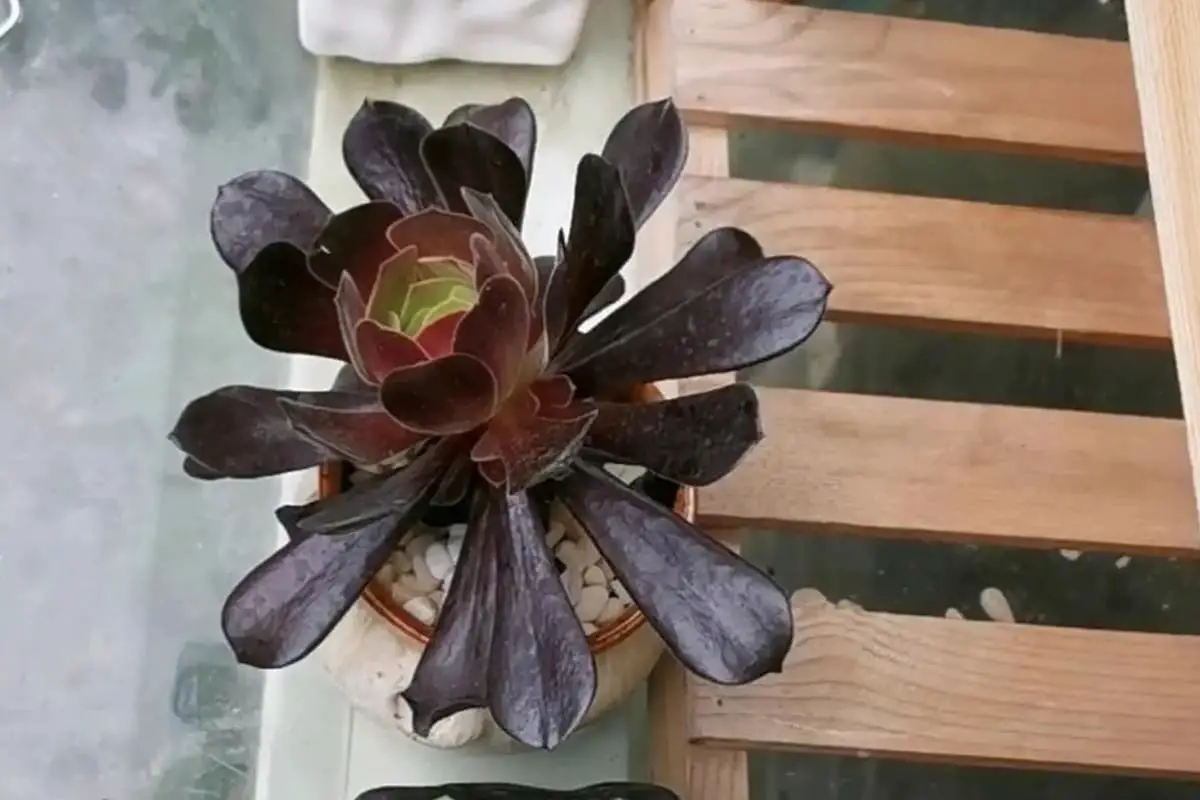
Aeonium arboreum ‘Zwartkop’, commonly known as “Black Rose” or “Black Tree Aeonium,” is a striking cultivar belonging to the Crassulaceae family and the Aeonium genus. This cultivar is renowned for its deep purple, almost black rosettes, which create a dramatic contrast in any garden or container arrangement.
While the species Aeonium arboreum is native to the Canary Islands, the ‘Zwartkop’ cultivar is a horticultural selection with no natural distribution. It has gained popularity worldwide due to its unique coloration and architectural form.
Morphology:
The ‘Zwartkop’ cultivar grows as a branching subshrub, reaching heights of up to 1.5 meters (5 feet). Its growth habit is characterized by multiple upright stems, each terminating in a large rosette of fleshy leaves. The rosettes can grow up to 20 cm (8 inches) in diameter. As the plant matures, the lower stems become woody and take on a light brown color, contrasting beautifully with the dark foliage.
Foliage:
The leaves are spatulate to obovate, measuring about 7-10 cm (3-4 inches) long and 3-4 cm (1-1.5 inches) wide. They are arranged in a tight spiral, forming the characteristic rosette. The deep purple-black color is most intense when the plant receives full sun exposure. In shadier conditions, the leaves may develop a greenish tint.
Cultural Requirements:
Aeonium ‘Zwartkop’ thrives in Mediterranean-like climates, preferring warm, dry environments with ample sunlight. It is drought-tolerant and adapted to withstand periods of water scarcity. The plant is considered a “winter-grower,” meaning it experiences its main growth period during the cooler months and may go semi-dormant in extreme summer heat.
This cultivar is sensitive to prolonged frost, tolerating brief periods down to about -1°C (30°F). In colder regions, it should be protected or moved indoors during winter. While it can tolerate partial shade, full sun exposure is crucial for maintaining the intense dark coloration of the leaves.
Soil and Watering:
‘Zwartkop’ requires well-draining, porous soil to prevent root rot. A mix formulated for succulents or cacti, with added perlite or pumice for improved drainage, is ideal. Water thoroughly when the soil is completely dry, but reduce watering frequency during its summer semi-dormancy period.
Landscape Use:
The dramatic appearance of Aeonium ‘Zwartkop’ makes it a popular choice for Mediterranean and xeriscape gardens, rock gardens, and as a focal point in container plantings. Its dark foliage provides excellent contrast when paired with lighter-colored succulents or drought-tolerant perennials.
In frost-free areas of coastal California and other Mediterranean climate zones, ‘Zwartkop’ has naturalized and can be found growing in gardens and occasionally escaping cultivation.
Propagation:
This cultivar is easily propagated from stem cuttings. Allow the cutting to callus for a few days before planting in well-draining soil. Rooting typically occurs within a few weeks.
In conclusion, Aeonium arboreum ‘Zwartkop’ is a striking and low-maintenance succulent that offers year-round interest with its deep purple-black rosettes. Its architectural form and drought tolerance make it an excellent choice for gardeners in suitable climates or as a distinctive container specimen in cooler regions.
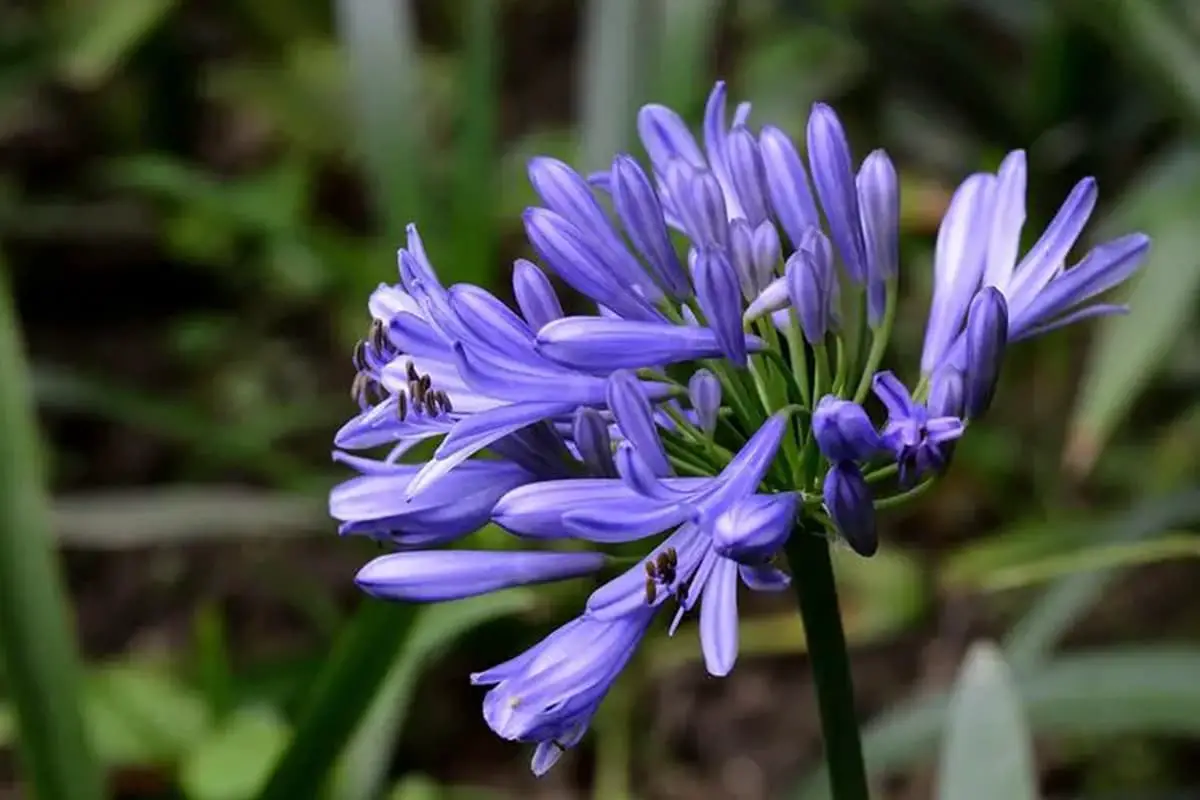
Agapanthus africanus, commonly known as African Lily or Lily of the Nile, is a striking herbaceous perennial belonging to the Amaryllidaceae family. This evergreen plant features a rhizomatous root system rather than a true bulb, which is a common misconception. Its leaves are basal, linear to strap-shaped, and glossy green with a slightly leathery texture, forming dense clumps that can reach 60-100 cm in height.
The flower stalks, or scapes, emerge from the center of the leaf rosettes, typically growing 1-2 meters tall. These sturdy stems are crowned with spectacular spherical umbels composed of 20-100 funnel-shaped flowers. The blooms are most commonly a striking blue-violet, though white cultivars are also popular. Flowering occurs from mid-summer to early autumn, generally peaking between July and August in the Northern Hemisphere.
Native to the Cape Province of South Africa, A. africanus has been widely cultivated globally, including various regions of China, due to its ornamental value and adaptability. It thrives in full sun to partial shade and prefers well-drained, fertile soils. While it appreciates consistent moisture during the growing season, established plants demonstrate good drought tolerance.
In terms of climate preferences, A. africanus is frost-tender and best suited to USDA hardiness zones 8-10. In colder regions, it’s often grown as a container plant and overwintered indoors. During active growth, it benefits from temperatures between 15-25°C (59-77°F), while winter temperatures should not fall below 5°C (41°F) for outdoor specimens.
Propagation is typically achieved through division of mature clumps in spring or by sowing fresh seeds in autumn. Division not only propagates the plant but also rejuvenates older specimens, improving flowering performance.
While Agapanthus has been used in traditional medicine, it’s important to note that all parts of the plant contain sapogenins, which can cause mild toxicity if ingested. In herbal applications, it has been employed to treat heart disease, coughs, and paralysis, though scientific evidence supporting these uses is limited.
In the language of flowers, Agapanthus symbolizes love, beauty, and fertility. Its name derives from the Greek “agape” (love) and “anthos” (flower), literally meaning “flower of love.”
Horticulturally, A. africanus is prized for its architectural form and long-lasting blooms. It’s excellent for mixed borders, coastal gardens, and large containers. The flowers are also valuable for cut flower arrangements, lasting up to two weeks in a vase. With proper care, including regular deadheading and occasional feeding with a balanced fertilizer, Agapanthus will provide years of stunning floral displays, making it a cherished addition to gardens worldwide.

Agastache rugosa, commonly known as Korean Mint or wrinkled giant hyssop, is a perennial herb belonging to the Lamiaceae family and Agastache genus. This aromatic plant is native to East Asia, particularly Korea, China, and Japan.
The stems of Agastache rugosa are erect, quadrangular, and finely pubescent, becoming glabrous towards the base. Its leaves are opposite, ovate to ovate-oblong, with a cordate or truncate base and serrated margins. The foliage exhibits a wrinkled texture, which is reflected in its specific epithet “rugosa.”
The inflorescence is a terminal spike, 10-15 cm long, bearing numerous small flowers. The corolla is bilabiate, typically pale purple to blue, though variations in color can occur. Each flower produces four small, ovate-cylindrical nutlets upon fruiting.
Korean Mint thrives in USDA hardiness zones 5-9. It prefers full sun to partial shade and well-draining, fertile soil. While it can tolerate some drought once established, it performs best with consistent moisture. The plant is not cold-hardy in extreme conditions and may require winter protection in colder regions.
Propagation is primarily through seeds, which can be sown directly in the garden after the last frost or started indoors 6-8 weeks before the last frost date. The plant also readily self-seeds in favorable conditions. Division of mature clumps in spring or fall is another effective propagation method.
In landscaping, Agastache rugosa serves multiple purposes. Its aromatic foliage and attractive flowers make it an excellent choice for sensory gardens, particularly in areas designed for the visually impaired. The plant’s strong, minty fragrance is released when the leaves are touched, enhancing the sensory experience. It’s also valuable in pollinator gardens, attracting bees, butterflies, and hummingbirds.
Medicinally, Korean Mint has been used in traditional East Asian medicine for centuries. It is believed to have carminative, antispasmodic, and mild sedative properties. The plant is used to treat various ailments, including digestive issues, colds, and headaches. However, it’s important to note that while traditional uses suggest benefits, scientific research on its efficacy is limited. As with any herbal remedy, caution should be exercised, and excessive consumption should be avoided. Individuals with certain health conditions or those taking medications should consult a healthcare professional before using Korean Mint medicinally.
In garden design, Agastache rugosa is versatile. It can be incorporated into herb gardens, mixed borders, or naturalized areas. Its upright habit makes it suitable for the middle or back of perennial borders. The plant’s tolerance for various soil types, including poor soils, makes it an excellent choice for slopes and roadside plantings where soil quality may be less than ideal.
For optimal growth and abundant flowering, regular deadheading is recommended. While generally pest-resistant, the plant may occasionally face issues with root rot in poorly drained soils or powdery mildew in humid conditions with poor air circulation.
In conclusion, Agastache rugosa is a multi-faceted plant that offers ornamental, sensory, and potential medicinal benefits. Its adaptability and low maintenance requirements make it a valuable addition to diverse garden settings, while its aromatic properties and attractive flowers enhance the overall garden experience.
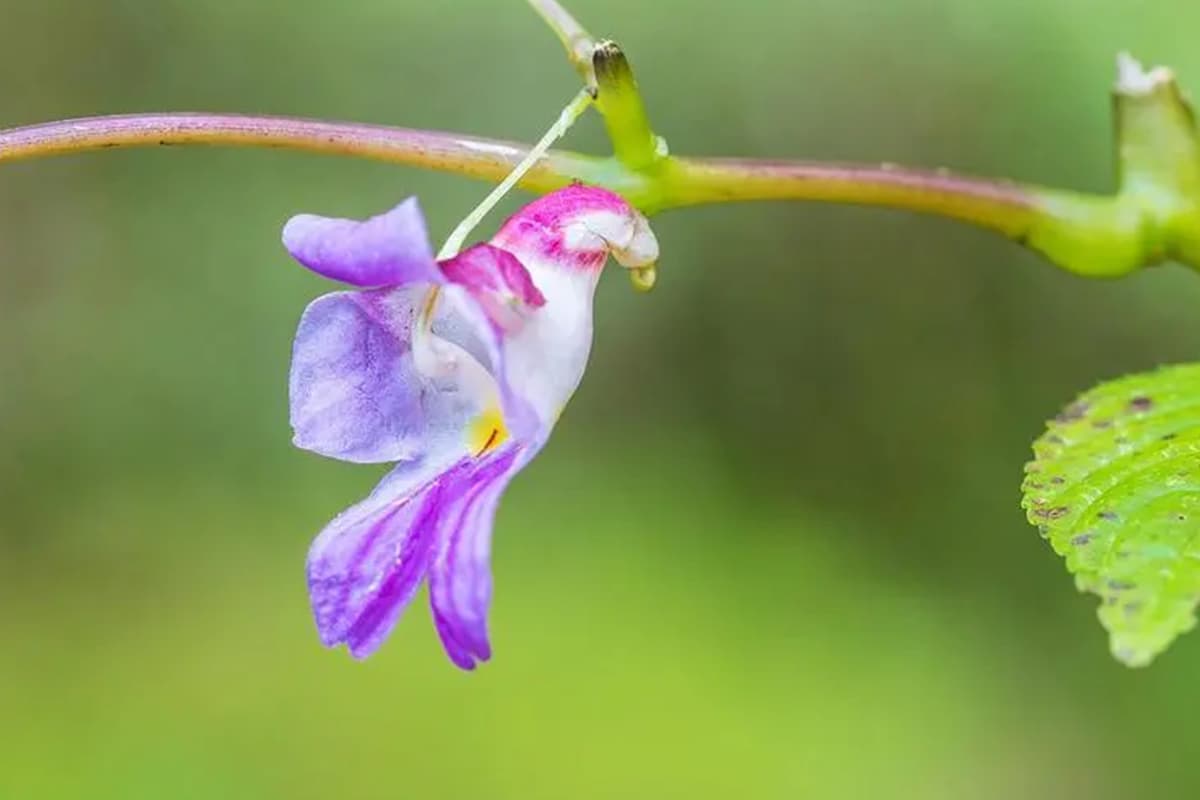
Agave desmettiana, commonly known as “Smooth Agave” or “Desmett’s Century Plant,” is a striking succulent plant belonging to the Asparagaceae family, not the Impatiens genus as previously stated. This perennial succulent forms a rosette and typically grows to a height of 0.9 to 1.2 meters (3 to 4 feet), with a spread of 1.2 to 1.8 meters (4 to 6 feet).
The plant’s leaves are thick, fleshy, and pale blue-green in color, often with a yellow variegation along the margins. They are lanceolate in shape, measuring 60-90 centimeters (24-36 inches) in length and 10-15 centimeters (4-6 inches) in width. The leaves have smooth or only slightly toothed edges, unlike many other agave species, hence its common name “Smooth Agave.”
Agave desmettiana thrives in well-draining soil and full sun to partial shade conditions. It is drought-tolerant and well-suited for xeriscaping in arid climates. This species is native to eastern Mexico but is widely cultivated as an ornamental plant in many parts of the world with suitable climates.
Propagation of Agave desmettiana is relatively straightforward, primarily occurring through offsets (pups) that grow around the base of the mother plant. These can be carefully removed and replanted. The plant also produces bulbils (small plantlets) on its flower stalk, which can be used for propagation.
After 10-15 years, the plant reaches maturity and produces a tall flowering stalk, which can reach up to 3-4 meters (10-13 feet) in height. The flowers are pale yellow to green and appear in clusters along the upper portion of this stalk. Following flowering, the main plant dies, but offsets will continue to grow.
While not as rare as initially described, Agave desmettiana is valued for its ornamental qualities and is often featured in botanical gardens and private collections worldwide. Its attractive form and relatively manageable size make it a popular choice for Mediterranean and desert-style landscaping.
It’s worth noting that this plant is sometimes confused with the “Parrot Flower” (Impatiens psittacina), which is an entirely different species native to Thailand and Myanmar. The Parrot Flower is indeed rare and challenging to cultivate, matching some of the characteristics described in the original text.

Ageratum conyzoides, commonly known as “Billygoat Weed” or “Goatweed”, is an annual herbaceous plant belonging to the Asteraceae family. This species is characterized by its fibrous root system, lacking a prominent taproot.
The stem is erect and branching, reaching a diameter of approximately 4 mm at the base. Its branches are often pale red or green in the upper portions, covered with fine, white, powdery trichomes. The leaves are oppositely arranged, ovate to elongate in shape, with serrated margins and a slightly hairy texture.
The inflorescence of A. conyzoides is a terminal corymb, consisting of numerous small flower heads. Each flower head is surrounded by involucral bracts that are bell-shaped or hemispherical, with elongate or lanceolate individual bracts. The florets are tubular, typically pale purple to lavender in color, and hairless on the outside or with powdery soft hairs at the tip. The fruit is a small, dark brown achene with a pappus of five white scales. Flowering occurs from July to December, depending on the climate.
Native to Central and South America, Billygoat Weed has become widely distributed across tropical and subtropical regions, including Africa, India, Southeast Asia, and parts of China. It thrives in warm, sunlit environments and adapts to a variety of soil types, though it prefers well-drained, fertile soils. The plant is not frost-tolerant and struggles in extreme heat.
A. conyzoides is commonly found in disturbed habitats such as valleys, forest edges, riversides, grassy mountain slopes, agricultural fields, and wastelands. Its rapid growth and prolific seed production contribute to its success as a weed. Propagation occurs primarily through seeds, which are easily dispersed by wind, and occasionally through stem cuttings.
In horticulture, Billygoat Weed is sometimes used in landscape design for its subtle flower colors and low-growing habit. It can be incorporated into flower beds, as a ground cover, in ornamental lawns, or as a filler plant in mixed borders. However, its potential to become invasive should be considered when using it in gardens.
Medicinally, A. conyzoides has been used in traditional practices across various cultures. The plant contains bioactive compounds with potential therapeutic properties. It has been employed to treat a range of ailments, including:
While traditional uses are widespread, it’s important to note that scientific research on the efficacy and safety of A. conyzoides for medicinal purposes is ongoing. Anyone considering its use for health purposes should consult with a qualified healthcare professional.
In conclusion, Ageratum conyzoides is a versatile plant with both ornamental and potential medicinal value. However, its aggressive growth habits necessitate careful management in cultivated settings to prevent it from becoming a nuisance weed.
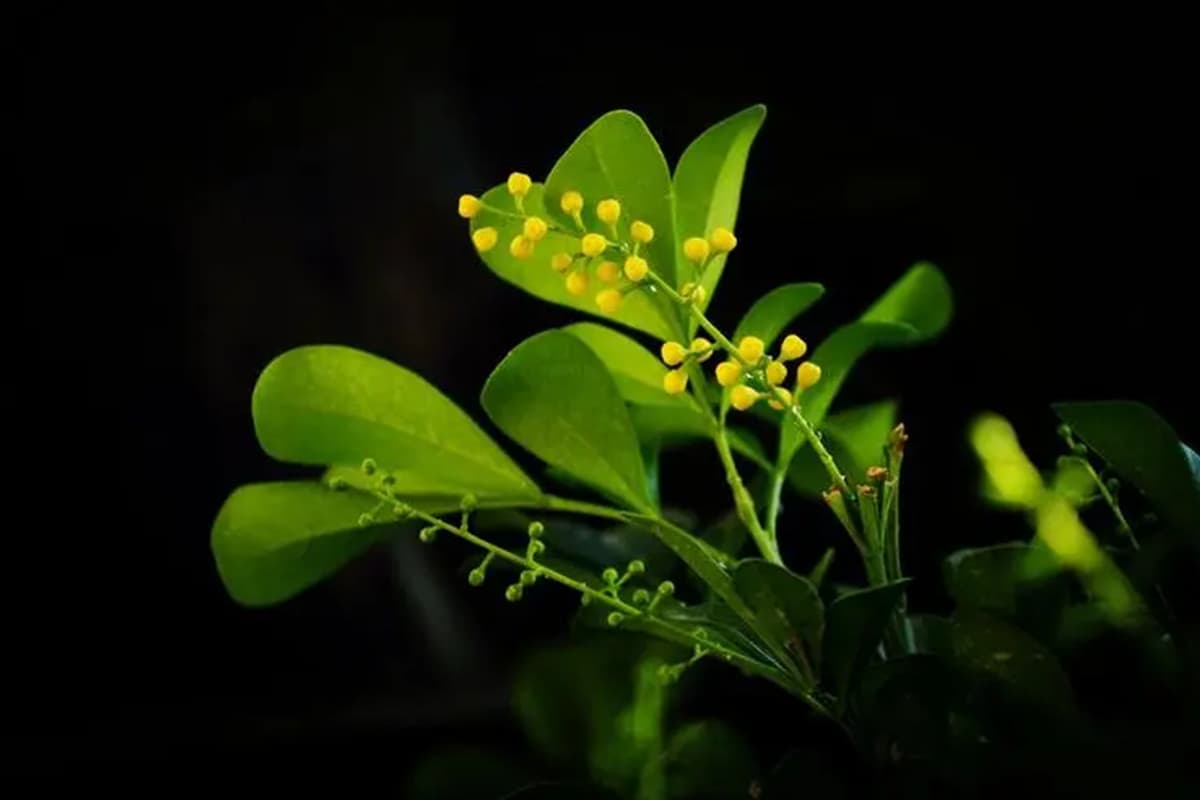
Aglaia odorata Lour., commonly known as “Chinese Rice Flower” or “Chinese Perfume Plant,” is a species belonging to the Meliaceae family and the genus Aglaia. This evergreen shrub or small tree is prized for its fragrant flowers and ornamental value.
Morphology:
The plant typically grows to a height of 3-8 meters, featuring a multi-branched structure. Its leaves are compound, alternately arranged, and pinnate, consisting of 5-9 leaflets. Each leaflet is ovate to elliptical in shape, with a glossy dark green upper surface and a paler underside. The petioles have narrow wings, a distinctive characteristic of this species.
Flowers:
The tiny, yellow flowers of A. odorata are its most notable feature. Measuring only about 3-4 mm in diameter, they resemble grains of rice, hence the common name “Chinese Rice Flower.” These flowers are arranged in axillary panicles and emit a strong, sweet fragrance, particularly intense during warmer periods and under full sun exposure.
Flowering period:
A. odorata has an extended flowering season, blooming through three seasons. However, the most prolific flowering occurs during summer and autumn, primarily from June to August. In optimal conditions, the plant may produce flowers year-round in tropical climates.
Native range and distribution:
Originally native to southern China and Southeast Asia, A. odorata has been widely cultivated and naturalized across many tropical and subtropical regions worldwide. It is commonly found in countries such as Vietnam, Thailand, Malaysia, and Indonesia.
Growing conditions:
This species thrives in warm, sunny locations but can tolerate partial shade. It performs best in USDA hardiness zones 10-11. The plant prefers well-draining, humus-rich, and slightly acidic soil with a pH range of 5.5-6.5. In its natural habitat, it often grows in sparse forests or shrublands on low-altitude mountains, typically below 1000 meters.
Propagation:
A. odorata is commonly propagated through air layering and stem cuttings. Seeds can also be used, but they have a short viability period and germination can be inconsistent. For stem cuttings, semi-hardwood cuttings taken in late spring or early summer tend to root most successfully.
Uses and cultural significance:
Care and maintenance:
A. odorata requires regular watering but should not be overwatered. It benefits from periodic pruning to maintain shape and promote bushier growth. In colder regions, it should be protected from frost or grown in containers that can be moved indoors during winter.
By providing the right growing conditions and care, A. odorata can be a rewarding addition to gardens in suitable climates, offering both visual appeal and a delightful fragrance.

Albizia julibrissin, commonly known as the “Silk Tree” or “Mimosa”, is a deciduous tree belonging to the Fabaceae family and Albizia genus. This ornamental tree is characterized by its broad, spreading canopy and delicate, fern-like foliage. The twigs feature distinct ridges, while young branches, leaves, and inflorescences are covered in fine, velvety hairs, contributing to the tree’s silky texture.
Contrary to the original description, the leaves of Albizia julibrissin are not needle-like or small. Instead, they are large, bipinnately compound, measuring 20-45 cm long and 12-25 cm wide. Each leaf consists of 10-25 pairs of pinnae, with each pinna bearing 40-60 small leaflets. The foliage is known for its feathery appearance and tends to close at night or when touched, exhibiting thigmonasty.
The flower clusters are indeed borne at the branch tips, but their shape is more accurately described as globular or pom-pom-like rather than conical. These showy inflorescences are composed of numerous silky threadlike stamens, typically in shades of pink to light pink, sometimes white. The flowers are fragrant and rich in nectar, attracting various pollinators.
The fruits of Albizia julibrissin are flat, oblong pods (legumes), typically 10-20 cm long and 2-3 cm wide. These pods start green and soft, maturing to a light brown and becoming papery and dry. The flowering period generally extends from June to August, with fruits developing and maturing from August through November.
Native to a wide range of Asia, from Iran to Japan and south to Taiwan, the Silk Tree has been widely cultivated and naturalized in many parts of the world, including North America, Europe, and Africa. It thrives in various habitats, including slopes, forest edges, and disturbed areas, often becoming invasive in some regions.
Albizia julibrissin is indeed a fast-growing tree that prefers full sun exposure. It demonstrates moderate cold hardiness (USDA zones 6-9), high drought tolerance, and adaptability to various soil types, though it performs best in well-drained, fertile soils. While it can withstand short periods of waterlogging, prolonged wet conditions can lead to root rot.
The wood of Albizia julibrissin is moderately hard, with a straight grain and fine texture. It’s used for furniture, cabinetry, and turned objects, though not as extensively as some other hardwoods due to its tendency to warp.
In traditional medicine, various parts of the tree have been used. The bark, particularly, contains julibrosides and other compounds with potential sedative and anti-anxiety effects, supporting its traditional use for treating restlessness, depression, and insomnia. However, it’s important to note that medicinal use should only be under professional guidance.
The Silk Tree’s economic value extends beyond its wood and medicinal uses. Its rapid growth, nitrogen-fixing capabilities, and ornamental qualities make it valuable for erosion control, shade provision, and landscape beautification. However, its potential for invasiveness in some ecosystems should be carefully considered before planting.
In urban settings, Albizia julibrissin is prized as a street tree and ornamental specimen, offering a tropical appearance with its feathery foliage and striking summer blooms. Its broad canopy provides excellent shade, while its fragrant flowers add sensory appeal to landscapes. However, its tendency to self-seed prolifically and potentially weak wood structure in some cultivars should be taken into account in landscape planning and maintenance.
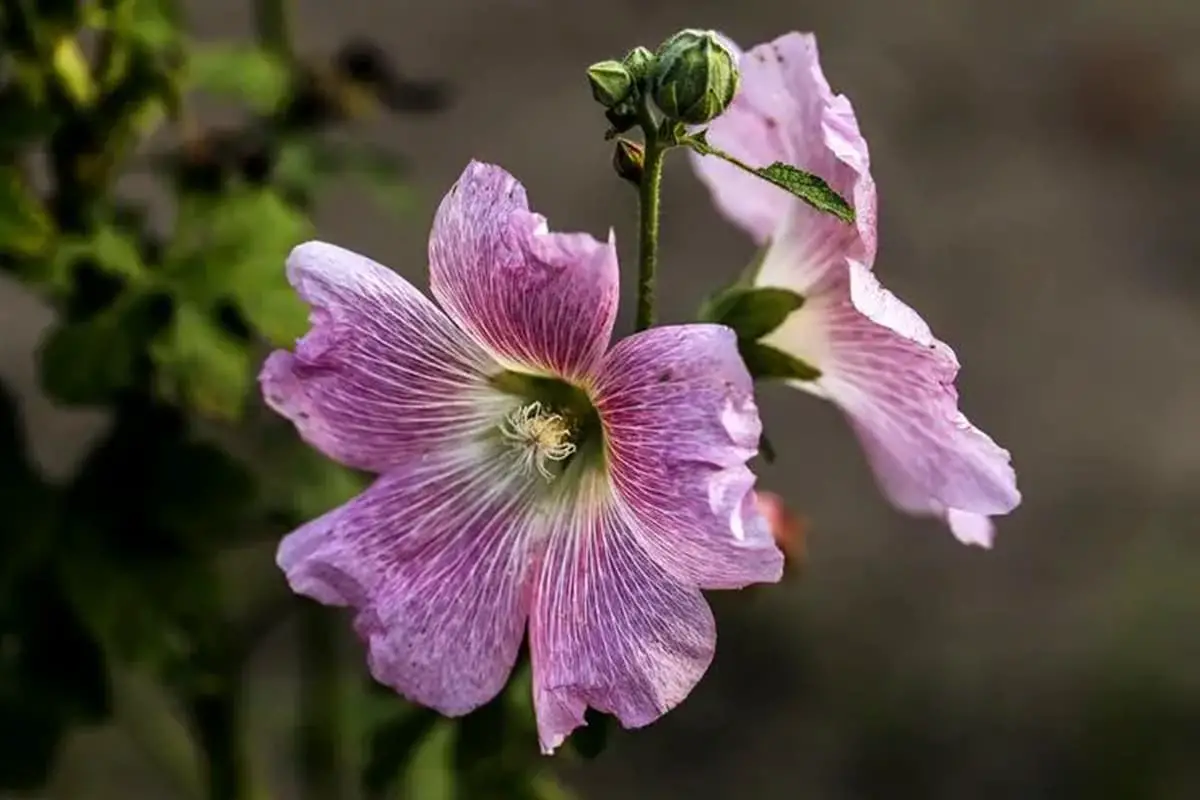
Alcea rosea, commonly known as “Hollyhock,” is a striking ornamental plant belonging to the Malvaceae family. This stately biennial or short-lived perennial is also referred to as “Duanwu Flower” in China due to its blooming coinciding with the Dragon Boat Festival (Duanwu Festival).
Hollyhocks are renowned for their impressive height, often reaching 2 to 3 meters (6-10 feet) tall. The robust stems are densely covered with stellate hairs and stiff trichomes, providing protection and giving the plant a slightly rough texture. The leaves are large and palmate, resembling a nearly round heart shape. They exhibit a sparse covering of stellate soft hairs on the upper surface, while the underside features stellate long stiff hairs or down, enhancing the plant’s ability to regulate water loss.
The flowers of Alcea rosea are its most striking feature, blooming prolifically from late spring through summer (typically February to August in its native range). They form on tall spikes, with individual blooms measuring 8-18 cm (3-7 inches) in diameter.
The flowers can be single or double-petaled, offering a diverse array of colors including deep purple, vibrant pink, rich red, pure white, and various pastel shades. This color variety has made hollyhocks a favorite among gardeners for centuries.
After flowering, the plant produces disc-shaped fruits covered in short, soft hairs. These fruits have distinct longitudinal grooves and contain kidney-shaped seeds, which are important for the plant’s reproduction and propagation.
Alcea rosea is native to China but has been widely cultivated around the world. It thrives in full sun but can tolerate partial shade, with the most robust growth occurring in areas with sparse shade. The plant demonstrates good cold resistance and prefers cool climates. For optimal growth, hollyhocks require well-draining, fertile, and deep soil with a pH between 6.0 and 8.0.
Propagation of hollyhocks can be achieved through several methods. Seed sowing is the most common, with seeds typically planted in late summer or early fall for blooming the following year. Division of established plants and stem cuttings are also effective methods, especially for preserving specific cultivars.
Beyond its ornamental value, Alcea rosea has been used in traditional medicine for centuries. The plant has a sweet taste and a cooling nature in traditional Chinese medicine. The root is believed to have properties that clear heat, detoxify the body, remove excess mucus, and promote diuresis.
The seeds are noted for their diuretic effects and potential in treating urinary tract infections, while the flowers are thought to aid in bowel movements and detoxification. However, it’s important to note that these medicinal uses should be approached with caution and under professional guidance.
In landscape design, hollyhocks serve multiple purposes. They are often used as dramatic vertical accents in the back of flower borders, planted along walls or fences to create living screens, or used as focal points in cottage-style gardens. Their tall stature, earning them the nickname “Yi Zhang Hong” or “Ten Feet Red” in Chinese, makes them excellent choices for creating privacy or adding architectural interest to garden designs.
Hollyhocks are relatively low-maintenance plants but can be susceptible to rust, a fungal disease that can be mitigated by ensuring good air circulation and avoiding overhead watering. With proper care, these majestic flowers can provide a stunning display in gardens year after year, attracting pollinators and adding a touch of old-world charm to any landscape.

Allamanda cathartica, commonly known as “Golden Trumpet,” is a striking ornamental plant belonging to the Apocynaceae family. This vigorous, vine-like shrub can reach heights of up to 6 meters in optimal conditions, featuring a milky sap characteristic of many plants in its family.
The foliage of A. cathartica is distinctive, with leaves arranged oppositely or in whorls of 3 to 5. These leaves are typically ovate to narrowly ovate or elliptical, measuring 6-15 cm long and 2-5 cm wide. They are dark green, glossy, and leathery in texture, providing an attractive backdrop for the plant’s showy flowers.
The flowers are the plant’s most striking feature, earning it the common name “Golden Trumpet.” These large, funnel-shaped blooms are a vibrant golden yellow and can measure 7 to 14 cm in length. The corolla tube is 4 to 8 cm long, cylindrical at the base and flaring into a bell shape at the top. Each flower typically has five broad, overlapping lobes that spread widely when fully open.
Following successful pollination, A. cathartica produces a distinctive fruit. This is a nearly spherical capsule, 3 to 7 cm in diameter, covered with sharp spines up to 1 cm long. When mature, these capsules split open to release flat seeds, each equipped with a membranous wing to aid in wind dispersal.
Native to northeastern South America, including Brazil, Guyana, and parts of the Caribbean, Golden Trumpet has been widely cultivated in tropical and subtropical regions worldwide due to its ornamental value. It thrives in USDA hardiness zones 10-12, where it can be grown as a perennial.
A. cathartica prefers warm, humid conditions and full sunlight for optimal growth and flowering. It demonstrates impressive heat and drought tolerance once established, but it’s sensitive to cold temperatures. The ideal temperature range for robust growth is between 22°C to 30°C (72°F to 86°F). Prolonged exposure to temperatures below 10°C (50°F) can cause damage or death to the plant.
While adaptable to various soil types, A. cathartica performs best in well-draining, fertile loamy soil with a pH between 6.0 and 6.5. Good drainage is crucial to prevent root rot, especially in areas with high rainfall or during periods of heavy watering. When planting, choose a location that receives at least 6 hours of direct sunlight daily to ensure abundant flowering. In areas with less light, the plant may grow but with reduced blooming.
Proper watering is essential for healthy growth. During the active growing season, typically spring through fall, maintain consistent soil moisture without waterlogging. Allow the top inch of soil to dry between waterings. In winter or cooler months, reduce watering frequency as the plant’s growth slows.
Fertilization plays a key role in promoting lush growth and prolific flowering. Incorporate a slow-release, balanced fertilizer into the soil at planting time. During the growing season, supplement with a water-soluble, high-phosphorus fertilizer (such as 5-10-5) every 2-4 weeks to encourage flowering. Cease fertilization in late fall and winter when growth naturally slows.
Propagation of A. cathartica is most successfully achieved through stem cuttings taken in spring or early autumn. Select semi-hardwood cuttings about 10-15 cm long, remove the lower leaves, and treat the cut end with rooting hormone before planting in a well-draining potting mix. Maintain high humidity around the cuttings until roots develop, typically within 4-6 weeks.
Regular pruning helps maintain the desired shape and size of the plant, especially when grown as a shrub or trained on a trellis. Prune after flowering to encourage bushiness and remove any dead or damaged growth. Be cautious when handling the plant, as the milky sap can cause skin irritation in some individuals.
With its vibrant flowers and lush foliage, Allamanda cathartica serves as an excellent choice for tropical gardens, containers, or as a colorful climber in frost-free regions. Its low-maintenance nature and long blooming period make it a favorite among gardeners seeking to add a touch of golden splendor to their landscapes.
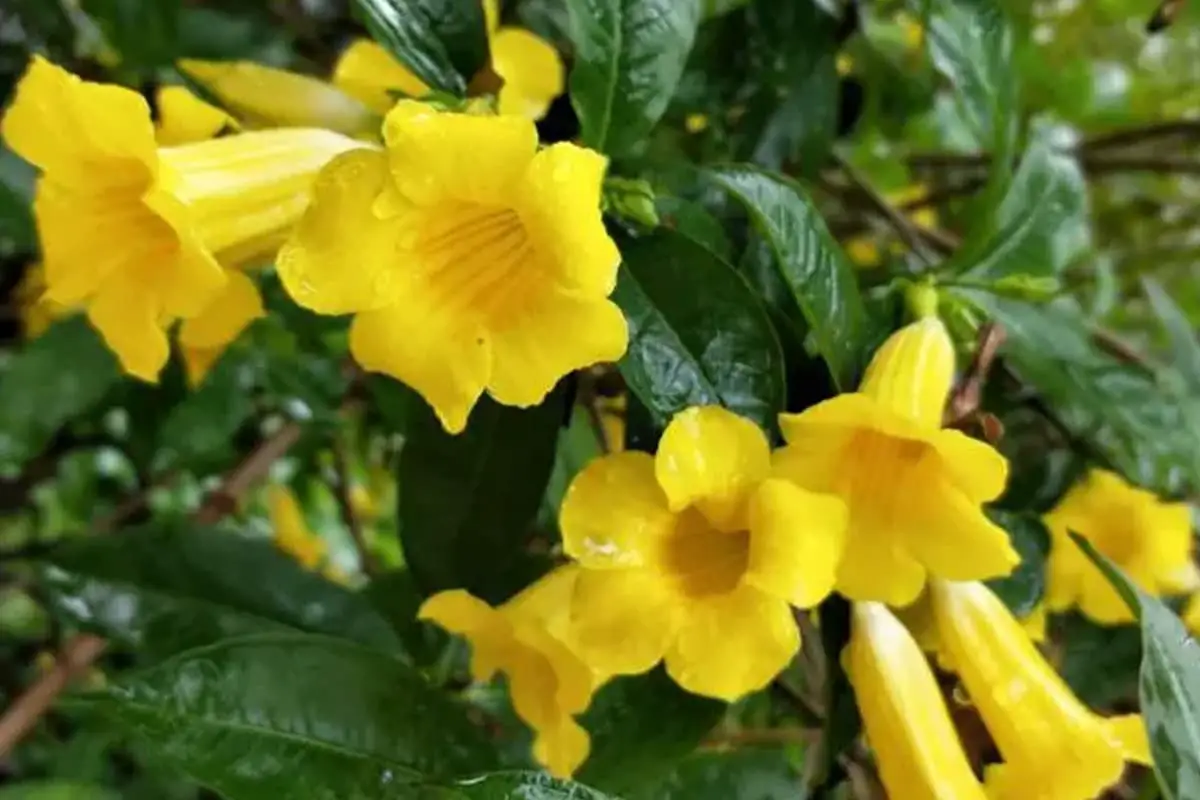
Allamanda neriifolia, commonly known as the Yellow Trumpet or Bush Allamanda, is a shrubby plant from the Apocynaceae family, belonging to the genus Allamanda. This evergreen shrub can grow up to 2 meters (6.5 feet) tall, forming a compact, bushy habit.
The plant features elliptical to narrowly ovate leaves, typically 5-15 cm long and 2-5 cm wide. The leaves are arranged oppositely on the stem and have a leathery texture with slightly raised venation. The undersides of the leaves exhibit prominent veins, and the petioles are notably short, usually less than 1 cm long.
The flowers of Allamanda neriifolia are its most striking feature. They are large, trumpet-shaped, and bright yellow, measuring 5-7 cm in diameter. The corolla is slender and funnel-shaped, with five overlapping lobes. Blooming occurs primarily between May and August, though in tropical climates, it may flower year-round.
The fruit is a spherical capsule, 2-3 cm in diameter, covered in long, soft spines. It matures from October to December, eventually splitting open to release numerous flat, winged seeds.
Native to Brazil, Allamanda neriifolia is now widely cultivated throughout tropical and subtropical regions of the Americas and beyond. It thrives in USDA hardiness zones 10-11, preferring warm, humid conditions with temperatures between 18-30°C (65-86°F). The plant requires full sun to partial shade and well-draining, fertile soil.
During its active growth phase, Allamanda neriifolia needs consistent moisture. Water deeply when the top inch of soil feels dry, and increase humidity by misting the foliage or using a pebble tray. In its dormant phase, typically during cooler months, reduce watering frequency to prevent root rot.
Propagation is primarily achieved through semi-hardwood stem cuttings taken in late spring or early summer. Seeds can also be used but are less common due to the plant’s hybrid nature in cultivation.
All parts of Allamanda neriifolia contain a milky sap that is toxic if ingested. The plant has a bitter taste and is considered to have a “cold” nature in traditional medicine systems. If consumed by humans or animals, it can cause symptoms such as increased heart rate, gastrointestinal distress, and respiratory issues. Pregnant animals may experience miscarriage if they ingest significant amounts.
Despite its toxicity, Allamanda neriifolia has several practical applications. Its insecticidal properties make it effective against mosquito larvae, contributing to pest control in some regions. When applied externally in controlled preparations, it may help reduce swelling and inflammation.
The plant’s ability to tolerate poor soil conditions and resist pollution makes it valuable for urban landscaping and revegetation of disturbed areas. It’s particularly useful for greening industrial and mining sites, highlighting its ecological and environmental significance.
In landscaping, Allamanda neriifolia is prized for its vibrant flowers and compact growth habit. It’s often used as a specimen plant, in mixed borders, or trained as a colorful hedge. Regular pruning after flowering helps maintain its shape and encourages bushier growth.
While beautiful and versatile, care should be taken when handling Allamanda neriifolia due to its toxic properties. Always wear gloves when pruning or propagating, and plant it away from areas frequented by children or pets.

Allium Giganteum, commonly known as Giant Onion, is a striking perennial bulbous plant belonging to the Allium family (Alliaceae). This impressive species stands out for its towering height and spectacular floral display.
Morphology:
The plant typically reaches a height of 120-150 centimeters (4-5 feet), significantly taller than the 30-60 centimeters mentioned earlier. Its basal leaves are broad, strap-like, and can grow up to 50 centimeters long and 10 centimeters wide. These leaves are glaucous green and often wither by flowering time.
The flower stalk, or scape, is robust and leafless, soaring to heights of 1.5 meters (5 feet) or more. It culminates in a massive, perfectly spherical umbel inflorescence that can measure up to 15-20 centimeters (6-8 inches) in diameter. This globe-shaped flowerhead comprises hundreds of small, star-shaped flowers in shades of deep purple to lilac. The blooming period typically spans from late spring to early summer, usually May to June.
Native Habitat and Distribution:
Allium Giganteum is native to Central Asia, particularly regions of Iran, Turkey, and parts of the western Himalayas. It has been introduced to many parts of the world as an ornamental plant, including China, Europe, and North America.
Cultivation Requirements:
This species prefers full sun to partial shade and thrives in well-drained, fertile soils rich in organic matter. While it can tolerate a range of soil types, it performs best in slightly alkaline conditions. The ideal temperature range for growth is indeed 15-25°C (59-77°F), but it’s worth noting that the plant is hardy and can withstand colder temperatures, surviving in USDA hardiness zones 5-8.
Propagation:
In cultivation, Allium Giganteum is primarily propagated through bulb division or seed sowing. Bulb division is best performed in late summer or early fall after the foliage has died back. Seeds can be sown in autumn or spring, but they may take several years to produce flowering-sized bulbs. Crop rotation is indeed crucial to prevent soil depletion and reduce the risk of pest and disease buildup.
Medicinal and Culinary Uses:
While the plant has been used traditionally to treat digestive issues like dysentery and diarrhea, it’s important to note that scientific evidence supporting these uses is limited. The entire plant contains sulfur compounds typical of the Allium genus, which contribute to its pungent aroma and potential medicinal properties. However, it’s primarily cultivated for ornamental purposes rather than medicinal or culinary use.
Ornamental Value:
Allium Giganteum is highly prized in ornamental horticulture for its dramatic architectural form and long-lasting blooms. It’s frequently used as a focal point in perennial borders, mixed beds, and naturalistic plantings. The dried seedheads are also attractive and can provide winter interest in the garden.
In the cut flower industry, it’s valued for its long vase life and striking appearance. The globular flowerheads are often used in both fresh and dried arrangements, adding a sculptural element to floral designs.
In conclusion, Allium Giganteum is a magnificent ornamental plant that offers gardeners and landscapers a combination of impressive stature, unique floral display, and ease of cultivation, making it a valuable addition to many garden styles and floral compositions.

Amethyst Wisteria, scientifically known as Wisteria sinensis, is a spectacular deciduous vine renowned for its breathtaking floral display. Its flower spikes, or racemes, are truly impressive, ranging from 60-80 centimeters in length and adorned with fragrant, purple blossoms. This vigorous climber exhibits a distinct growth habit, with stems that twist counterclockwise, robust branches, and young shoots covered in soft, white pubescence that sheds as the plant matures.
The winter buds of Amethyst Wisteria are ovate and protected by overlapping scales. Its compound leaves are odd-pinnate, measuring 15-25 centimeters long, with early-deciduous lanceolate stipules. Each leaf typically comprises 3-6 pairs of leaflets plus a terminal leaflet. These leaflets are papery in texture, ranging from ovate-elliptical to ovate-lanceolate in shape, and are arranged along the rachis.
The inflorescence of Amethyst Wisteria is a pendulous raceme that emerges from axillary or terminal buds on the previous year’s short branches. These stunning floral clusters measure 15-30 centimeters in length and 8-10 centimeters in diameter, creating a cascading effect of color. Flowering occurs in spring, typically from April to May, followed by a fruiting period from May to August. The fruits are elongated, flattened pods containing seeds.
Native to China, Amethyst Wisteria naturally occurs in regions south of the Yellow River and along the Yangtze River basin. Its distribution includes provinces such as Shaanxi, Henan, Hubei, Anhui, Jiangsu, Zhejiang, Jiangxi, Hunan, Guangxi, Guizhou, and Yunnan. This wide range demonstrates the plant’s adaptability to various climatic conditions within temperate and subtropical zones.
Amethyst Wisteria has been cultivated in Chinese gardens for centuries, prized for its ornamental value and use as a trellis or pergola plant. Its horticultural significance lies in its unique flowering characteristic – the blossoms appear before the leaves fully emerge in spring. This phenological trait creates a striking visual effect, with the lavender-purple flower cascades contrasting beautifully against the sparse, tender young leaves and bare woody structure of the vine.
In landscape design, Amethyst Wisteria serves as a focal point, adding vertical interest and romantic charm to gardens. Its robust growth and longevity make it suitable for covering large structures, but it requires sturdy support due to its substantial weight when mature. Regular pruning is essential to maintain its shape and promote abundant flowering.
While celebrated for its beauty, gardeners should be aware that all parts of Wisteria sinensis are toxic if ingested, containing compounds such as wisterin and lectin. Therefore, caution is advised when planting in areas accessible to children or pets. Despite this consideration, with proper care and placement, Amethyst Wisteria remains a beloved and iconic flowering vine in horticultural circles worldwide.
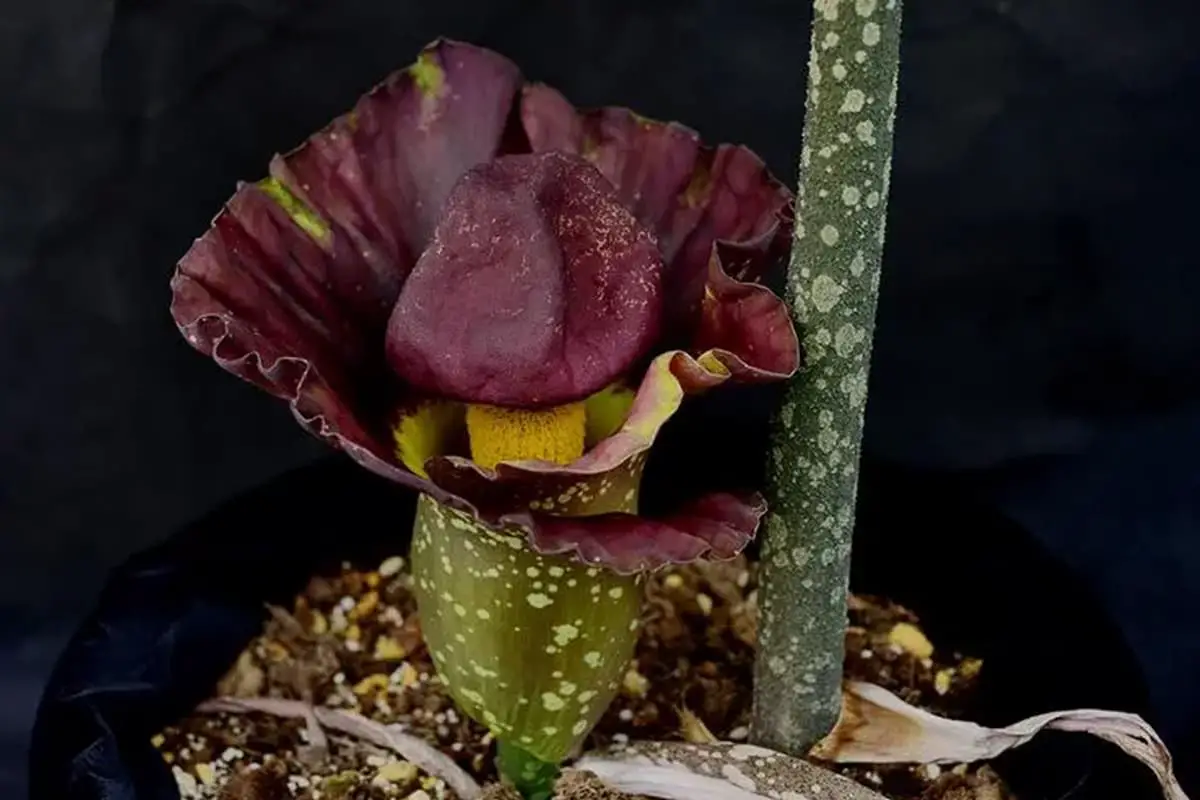
Amorphophallus paeoniifolius, commonly known as Elephant Foot Yam or Whitespot Giant Arum, is a remarkable perennial herbaceous plant belonging to the Araceae family. This species is distinguished by its massive underground tuber, which can weigh up to 15 kg and reach 50 cm in diameter, resembling an elephant’s foot.
The plant’s morphology is striking. Its solitary leaf emerges from the tuber, growing up to 1.5 meters tall. The petiole is thick, smooth, and mottled with pale green or pinkish-white patterns on a dark green background. The leaf blade is highly dissected, forming a parasol-like structure up to 2 meters in diameter. It consists of numerous leaflets that are oblong to ovate-lanceolate, with acuminate tips and a deep green color, often bearing pale white variegations.
The inflorescence, which appears before or after the leaf, is equally impressive. It consists of a large spadix enclosed by a spathe. The spadix can reach up to 60 cm in height, with female flowers at the base, followed by male flowers above. The spathe is broadly ovate, up to 50 cm long, and typically colored in shades of purple or maroon with white or pale green spots. This unique floral structure emits a strong, unpleasant odor to attract pollinators, primarily flies and beetles.
After pollination, the female flowers develop into a fruiting structure bearing numerous red, ellipsoid berries. Each berry contains one or two seeds. The plant’s reproductive cycle is aligned with seasonal changes, with flowering typically occurring between April and June, and fruiting from August to November, depending on the specific climate.
A. paeoniifolius is native to tropical and subtropical regions of Asia, including parts of India, Southeast Asia, and southern China. It thrives in humid, warm climates with well-drained, fertile soils. In its natural habitat, it can be found in diverse ecosystems ranging from lowland forests to cultivated areas.
Cultivation of this species has both ornamental and practical applications. In landscaping, it serves as a dramatic focal point in tropical gardens, particularly effective when planted in groups or as a specimen plant. Its unique foliage and inflorescence make it a conversation piece in any garden setting.
Beyond its ornamental value, A. paeoniifolius has significant importance in traditional medicine and as a food source. The tuber is rich in nutrients, including carbohydrates, proteins, and minerals. It’s widely consumed in parts of Asia, often prepared by boiling, frying, or roasting to remove its acridity.
In traditional medicine systems, various parts of the plant are used to treat a range of conditions. The tuber is believed to have anti-inflammatory, analgesic, and antioxidant properties. It’s used in the treatment of gastrointestinal disorders, respiratory ailments, and skin conditions. However, it’s crucial to note that the raw tuber contains calcium oxalate crystals and other compounds that can cause irritation, so proper preparation is essential before consumption or medicinal use.
Propagation of A. paeoniifolius is typically done through division of the tuber or by seeds. When grown from seeds, it may take several years for the plant to reach maturity and produce its characteristic large tuber and inflorescence.
In conclusion, Amorphophallus paeoniifolius is a fascinating plant that combines striking ornamental qualities with practical uses. Its unique morphology, ecological adaptations, and cultural significance make it an important species in both horticultural and ethnobotanical contexts. As with many plants of medicinal interest, further research is needed to fully understand and validate its potential health benefits.
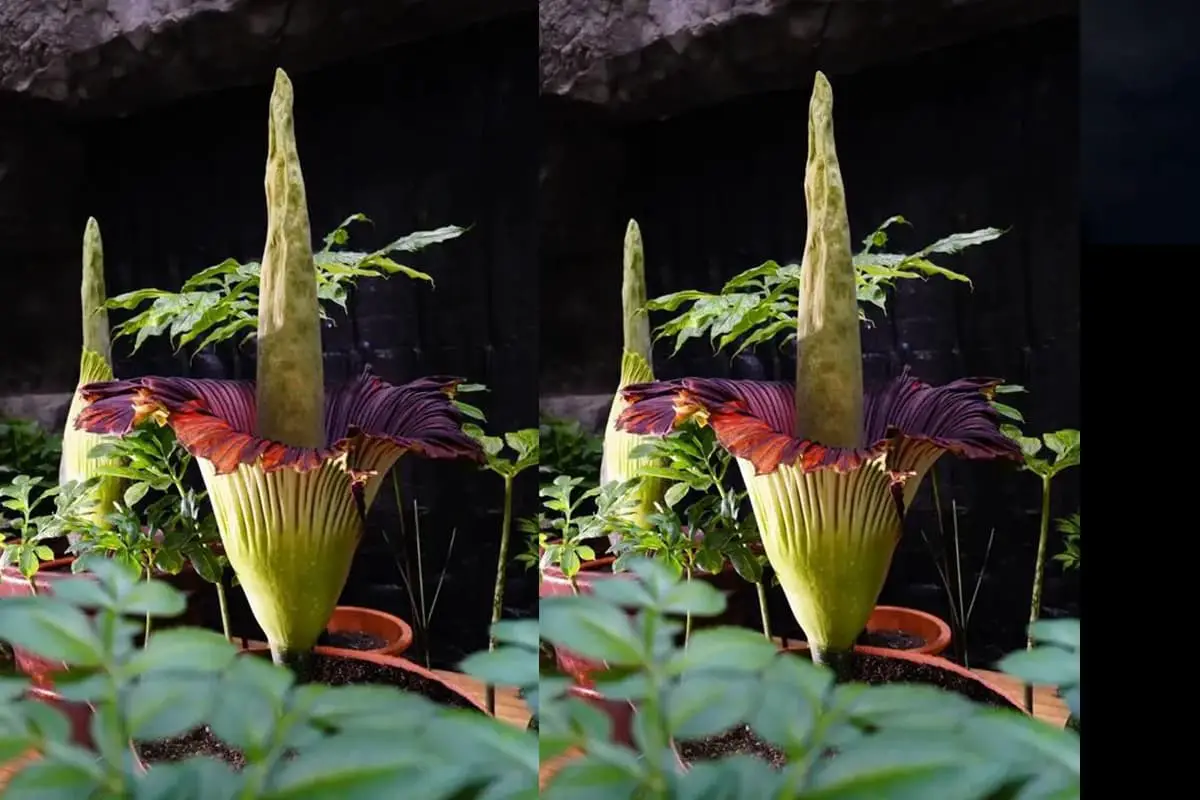
Amorphophallus titanum, commonly known as the Titan Arum or Corpse Flower, is a remarkable species belonging to the Araceae family. This extraordinary plant, native to the tropical rainforests of western Sumatra, Indonesia, specifically the Barisan Mountain Range, has captivated botanists and plant enthusiasts worldwide with its massive size and unique characteristics.
The Titan Arum possesses a colossal underground tuber, which can reach an impressive diameter of up to 1.5 meters and weigh over 100 kilograms. This tuber serves as an energy reserve, supporting the plant’s infrequent but spectacular blooming events.
During its vegetative phase, the plant produces a single leaf that emerges from the tuber. This leaf is truly massive, with a petiole typically reaching 3-4 meters in height. The leaf blade itself can span over 5 meters in diameter, creating a canopy that covers an area exceeding 20 square meters. This expansive leaf allows the plant to efficiently capture sunlight in its shaded rainforest habitat.
The inflorescence of A. titanum is one of the largest in the plant kingdom, often reaching heights of 2-3 meters. It consists of a tall spadix surrounded by a spathe, which unfurls to reveal a deep burgundy color reminiscent of rotting flesh. This visual display, combined with the inflorescence’s notorious odor, has earned the plant its common name, the Corpse Flower.
The plant’s signature scent, often described as a combination of rotting fish, sweaty socks, and decaying meat, serves a crucial ecological function. This pungent odor, along with the spathe’s color and elevated temperature, attracts carrion insects that act as pollinators. The bloom typically lasts only 24-48 hours, making it a rare and fleeting spectacle.
In cultivation, A. titanum requires specific conditions to thrive. It prefers well-draining, fertile soil rich in organic matter. While the plant requires consistent moisture, waterlogged conditions can lead to tuber rot, a common issue in cultivation. Optimal growth temperatures range from 25-38°C during the day and 20-25°C at night, mimicking its tropical habitat.
The Titan Arum’s life cycle is characterized by alternating periods of growth and dormancy. After flowering or producing a leaf, the plant enters a dormant phase where the tuber rests underground. This cycle can last several years between blooming events, contributing to the rarity and excitement surrounding its flowering.
Conservation efforts for A. titanum are crucial, as its native habitat faces threats from deforestation and climate change. Many botanical gardens worldwide cultivate this species, contributing to ex-situ conservation and providing opportunities for public education about this fascinating plant.
In conclusion, Amorphophallus titanum stands as a testament to the diversity and wonder of the plant kingdom. Its enormous size, unique blooming process, and ecological adaptations make it not only a valuable subject for scientific study but also a charismatic ambassador for plant conservation and biodiversity awareness.

Amygdalus persica var. pendula, commonly known as the Weeping Peach, is a cultivated variety of the peach tree belonging to the Rosaceae family. This ornamental tree is prized for its graceful, pendulous growth habit and stunning floral display.
The leaves of the Weeping Peach are lanceolate to narrowly elliptical, measuring up to 15 cm long and 4 cm wide. They feature finely serrated margins, a long acuminate tip, and a glossy dark green upper surface. Distinctive nectar glands are present at the base of the leaf blade or on the petiole. As the tree matures, its bark develops a dark gray color with characteristic fissures.
The flowers are the tree’s most striking feature, blooming profusely in early spring before the leaves fully emerge. They are solitary, measuring approximately 4 cm in diameter, and range in color from pale to deep pink, with some cultivars producing white blossoms. The flowers are typically semi-double or double-petaled, giving them a full, luxuriant appearance. In Chinese, these ornamental peach blossoms are collectively referred to as “Bì Táo.”
Flowering usually occurs between March and April in East China, though exact timing can vary depending on local climate conditions. Several cultivars have been developed, including red-flowered green-leaved types, red-flowered red-leaved varieties, and bi-colored forms with red and white speckled petals.
While the Weeping Peach is primarily grown for its ornamental value, it does produce edible fruit. The peaches are nearly spherical, covered with a soft fuzz, and typically measure around 7.5 cm in diameter. The skin is orange-yellow with a red blush. Inside, the fruit contains a deeply pitted and grooved stone enclosing a white seed.
Due to its high ornamental value and relatively compact size, the Weeping Peach is a popular choice for urban landscapes. It is frequently planted in residential neighborhoods, parks, and along streets, where its cascading branches and abundant spring blossoms create a spectacular display.
When cultivating Weeping Peach trees, it’s important to provide them with full sun exposure and well-draining soil. They benefit from regular pruning to maintain their weeping form and encourage healthy growth. Like other peach varieties, they may be susceptible to certain pests and diseases, so proper care and monitoring are essential for maintaining the tree’s health and beauty.

Ananas comosus, commonly known as the pineapple plant, belongs to the Bromeliaceae family and is a perennial herbaceous plant. While not typically referred to as a “Pineapple Flower,” the plant does produce a striking inflorescence that develops into the familiar pineapple fruit.
The leaves of Ananas comosus are long, sword-shaped, and arranged in a spiral rosette pattern. They are typically 30-100 cm long and 5-8 cm wide, with serrated edges. The leaves are glossy green, often with a bluish tinge, and have a waxy coating that helps conserve water.
The inflorescence of Ananas comosus emerges from the center of the rosette. It consists of 100-200 flowers spirally arranged on a fleshy axis. The individual flowers are small, typically lavender or purple, and produce no nectar. As the fruit develops, it is crowned by a cluster of short leaves known as the “crown” or “top.”
Native to South America, particularly the regions encompassing southern Brazil and Paraguay, Ananas comosus has been widely cultivated in tropical and subtropical areas worldwide. It thrives in temperatures between 65-95°F (18-35°C) and requires well-draining soil with high organic content. While it prefers full sun in most climates, some shade may be beneficial in extremely hot regions.
Ananas comosus is indeed efficient in carbon dioxide absorption and oxygen production, making it an excellent air-purifying plant. However, it’s primarily cultivated for its fruit rather than as an ornamental plant.
Reproduction of Ananas comosus can occur through various methods:
While Ananas comosus is not typically grown indoors for long-term display due to its size and specific growing requirements, dwarf varieties can be cultivated as houseplants. These smaller versions retain the unique structure and elegant leaf shape of their larger counterparts, offering visual appeal throughout the year.
In conclusion, Ananas comosus is a fascinating plant known more for its fruit than its flowers. Its unique growth habit, efficient air-purifying qualities, and the potential for indoor cultivation of dwarf varieties make it an interesting subject for both agricultural and horticultural pursuits.
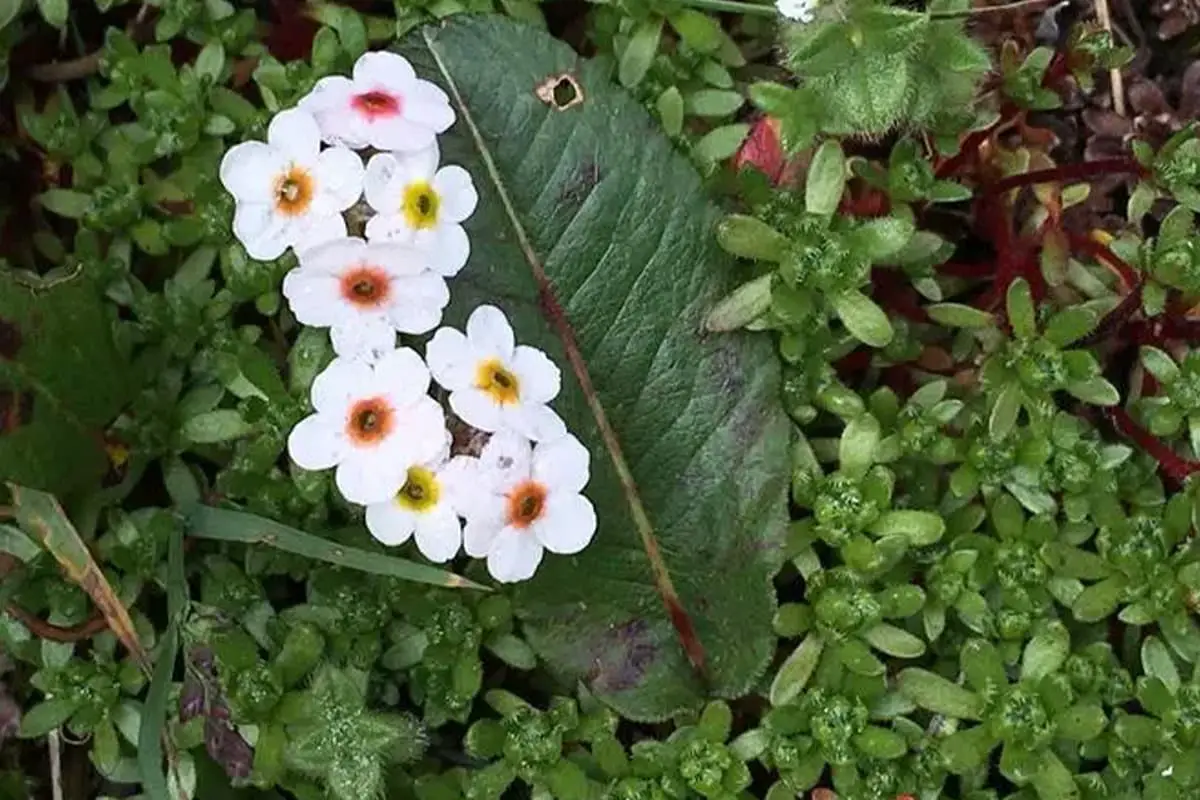
Androsace umbellata, commonly known as Rock Jasmine, is a delicate biennial or short-lived perennial herb belonging to the Primulaceae family. This species is characterized by its rosette-forming leaves, which can be either homomorphic or heteromorphic, arranged basally or clustered at the base of the flowering stem.
The inflorescence of A. umbellata typically consists of an umbel-like cluster at the apex of a slender scape, though solitary flowers may occasionally occur. Each umbel generally contains 2-10 small, white or pale pink flowers. The calyx is campanulate to cup-shaped, with five lobes that are approximately equal in length to the corolla tube.
The corolla is salverform, featuring five spreading lobes with a yellow or pink eye at the center. Each flower measures about 5-8 mm in diameter. The fruit is a globose capsule, slightly exceeding the persistent calyx, and contains numerous small, angular seeds.
A. umbellata has a relatively short blooming period, typically flowering from late winter to early spring (February to April). The fruiting period follows shortly after, usually occurring from May to June.
This species has a wide distribution across East Asia, found in various provinces of China, as well as in Vietnam, North Korea, and Japan. It demonstrates a preference for moist, well-drained soils in areas with partial to full sun exposure. A. umbellata is often found growing naturally in montane and subalpine regions, inhabiting meadows, rocky slopes, forest edges, and along roadsides or river valleys, typically at elevations between 1000-3500 meters.
Propagation of A. umbellata is primarily achieved through seed sowing. Seeds should be sown fresh in autumn or stratified if sowing in spring. Light is often required for germination, so seeds should be surface-sown or only lightly covered.
In traditional Chinese medicine, A. umbellata has been used for its medicinal properties. The plant is considered to have a bitter and pungent taste with a slightly cold nature. It is believed to possess heat-clearing, detoxifying, anti-inflammatory, and analgesic properties.
Historically, it has been employed to treat various ailments, including sore throats, toothaches, respiratory issues, and topically for swollen wounds or injuries. However, it’s important to note that medicinal use should only be under professional guidance.
In horticulture, A. umbellata’s compact growth habit and charming flowers make it an excellent choice for rock gardens, alpine troughs, or as a ground cover in partially shaded areas. Its diminutive size (usually not exceeding 10 cm in height) and early blooming period add interest to gardens in late winter and early spring. The plant’s flowers, while small, can be used in pressed flower art, adding a delicate touch to botanical crafts.
For successful cultivation, A. umbellata requires well-drained, humus-rich soil and protection from excessive winter wetness. In warmer climates, it benefits from afternoon shade, while in cooler regions, it can tolerate full sun. Regular division every few years helps maintain vigor and promote longevity in garden settings.
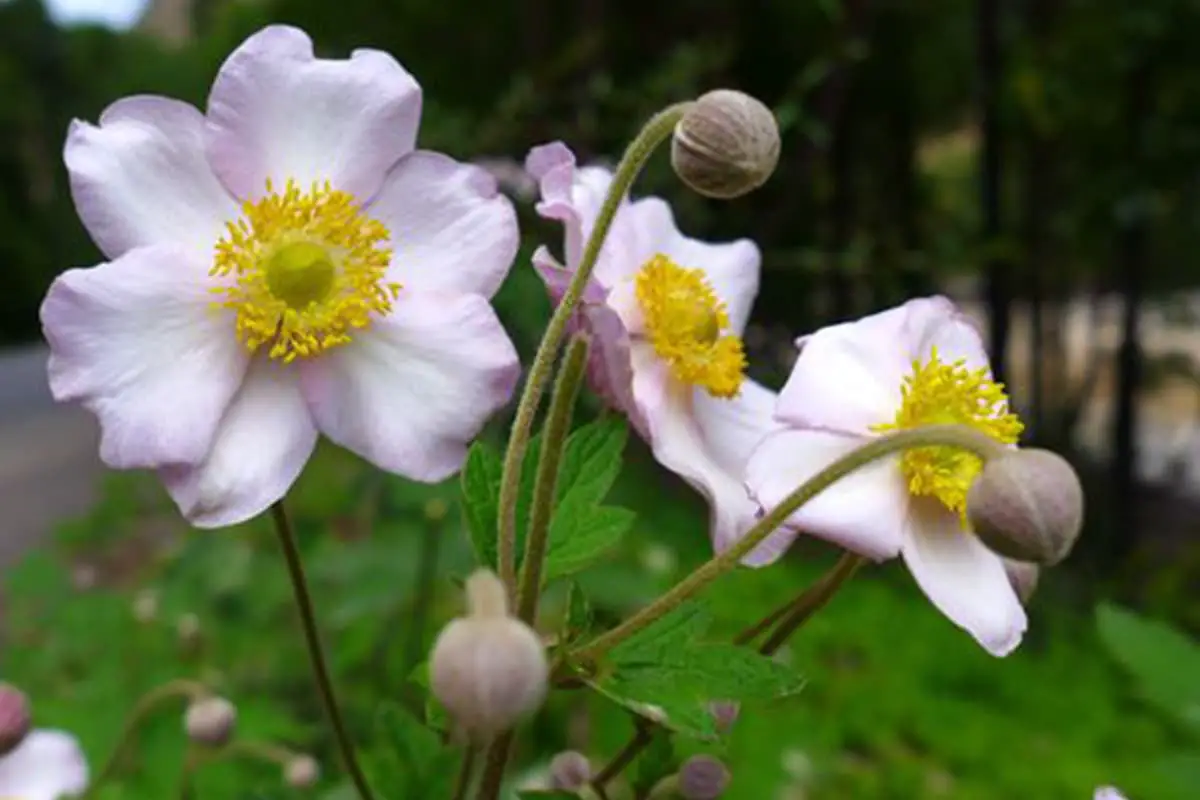
Anemone raddeana, commonly known as Radde’s Anemone, is a perennial herbaceous plant belonging to the Ranunculaceae family. This species is characterized by its horizontally extended or obliquely oriented rhizome, which is thin, jointed, and adorned with scale-like leaves. The plant typically produces a single basal leaf that is trifoliate in structure.
The leaf stalk of A. raddeana can be glabrous or sparsely pubescent with long, soft hairs. The central leaflet is ovate to elliptical in shape, featuring sparse dentate margins. The flower stem, or scape, is nearly glabrous and supports a solitary flower.
The flowers of Radde’s Anemone are notable for their numerous sepals, which give the appearance of double petals – a distinguishing feature from many other anemone species. These sepals are white or occasionally tinged with a subtle purple hue, elongated-oval in shape, and glabrous. The flowering period typically spans from April to May.
Following pollination, the plant produces narrowly ovate achenes covered in fine hairs. The fruiting period extends from May to June.
Geographically, A. raddeana is native to parts of East Asia, including China, North Korea, and the Russian Far East. It thrives in mountainous forests and shaded meadows, typically at elevations around 800 meters above sea level. This species demonstrates cold hardiness but has low heat tolerance, preferring fertile, well-draining soils rich in organic matter.
Propagation of Radde’s Anemone can be achieved through both seed dispersal and rhizome division. For cultivation, it’s important to provide partial shade and consistently moist, but not waterlogged, soil conditions.
The rhizome of A. raddeana has been utilized in traditional medicine, particularly in Chinese herbal practices. It is characterized by a spicy taste and is considered warm in nature according to traditional Chinese medicine principles. However, it’s crucial to note that the rhizome contains toxic compounds and should only be used under professional guidance.
Traditionally, the rhizome has been employed for its purported abilities to dispel wind and dampness, alleviate pain by dispersing cold, and reduce abscesses and swelling. Modern pharmacological studies have begun to investigate these traditional uses, with preliminary research suggesting potential anti-tumor, anti-inflammatory, analgesic, and sedative properties.
It’s important to emphasize that while A. raddeana has a history of medicinal use, any application should be approached with caution due to its toxicity. Further scientific research is needed to fully understand its pharmacological profile and potential therapeutic applications.
In horticultural settings, Radde’s Anemone is valued for its delicate, early spring blooms and ability to naturalize in woodland gardens. Its preference for partial shade and moist conditions makes it an excellent choice for shaded border plantings or as ground cover in areas with dappled sunlight.

The Anthurium Andraeanum, commonly known as the Flamingo Flower or Flamingo Lily, is a striking perennial evergreen herbaceous plant belonging to the Araceae family. This tropical beauty features a short stem from which its distinctive leaves emerge.
The foliage of A. andraeanum is characterized by glossy, dark green leaves that are leathery in texture and cordate (heart-shaped) to ovate-cordate in form. These leaves typically measure 20-30 cm in length and are supported by slender petioles. The leaf margins are entire, contributing to the plant’s elegant appearance.
What makes the Flamingo Flower truly remarkable is its inflorescence. The plant produces a spathe, which is often mistaken for a flower but is actually a modified leaf. This spathe is waxy, leathery, and heart-shaped, typically displaying vibrant shades of red, orange, or pink. Rising from the spathe is a straight or slightly curved spadix, usually yellow or white, which bears the tiny true flowers. This striking combination of spathe and spadix can last for several weeks, with the plant capable of blooming year-round under optimal conditions.
Native to the tropical rainforests of Colombia and Ecuador (rather than Costa Rica), A. andraeanum often grows as an epiphyte on trees. However, it can also be found growing terrestrially on the forest floor or occasionally on rocks. In its natural habitat, it thrives in warm, humid conditions with dappled sunlight filtering through the forest canopy.
For cultivation, the Flamingo Flower prefers temperatures between 60-90°F (15-32°C) and high humidity levels of 60-80%. It performs best in bright, indirect light, as direct sunlight can scorch its leaves. A well-draining, organic-rich potting mix is ideal for container growing.
The unique beauty and long-lasting blooms of A. andraeanum make it a versatile ornamental plant. It excels as a potted specimen for interiors or sheltered outdoor spaces in suitable climates. Its cut flowers are prized in the floral industry for their exceptional vase life, often lasting up to three weeks. In tropical and subtropical gardens, it can be used to add color to shaded areas, either planted in the ground or in containers.
While primarily grown for ornamental purposes, it’s worth noting that all parts of the Anthurium andraeanum contain calcium oxalate crystals, which can cause irritation if ingested or if the sap comes into contact with skin. Therefore, care should be taken when handling the plant, especially around children and pets.
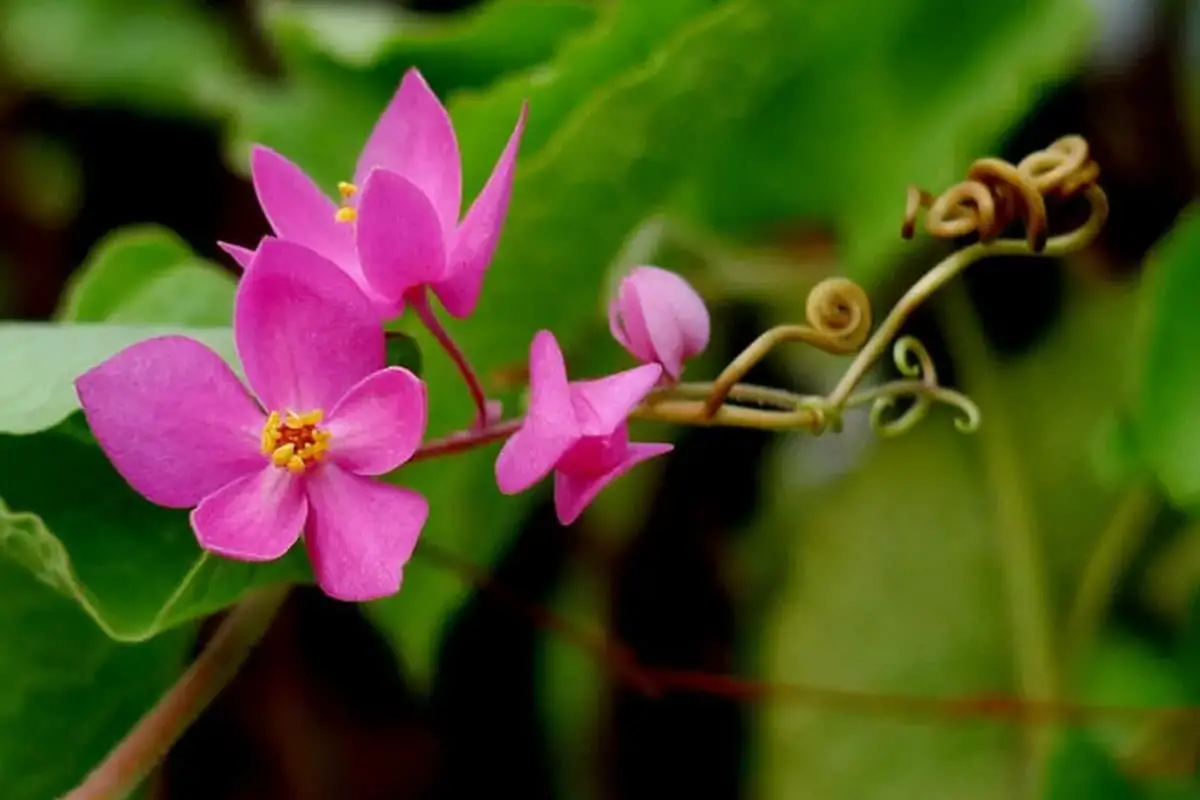
The Antigonon leptopus, commonly known as Coral Vine or Mexican Creeper, is a striking perennial vine belonging to the Polygonaceae family. This vigorous climber, native to Mexico, has become a popular ornamental plant in tropical and subtropical regions worldwide due to its prolific blooming and adaptability.
Morphology:
The Coral Vine features a tuberous root system and slender, twining stems that can reach lengths of up to 12 meters (40 feet). Its leaves are heart-shaped to triangular, measuring 5-10 cm long, with a pointed tip and prominent veins. The foliage is typically bright green, providing an attractive backdrop for the showy flowers.
Inflorescence:
The plant’s most distinctive feature is its abundant, cone-shaped inflorescences. These racemes are composed of numerous small flowers, each about 1 cm in diameter, ranging in color from deep pink to coral-red, and occasionally white. The upper portion of the raceme axis cleverly modifies into tendrils, allowing the vine to climb and secure itself to supports.
Blooming Period:
Antigonon leptopus boasts an impressively long flowering season, typically blooming from late spring (April) through early winter (December) in suitable climates. This extended bloom period makes it a valuable addition to gardens seeking year-round color.
Cultural Requirements:
The Coral Vine thrives in full sun exposure and prefers warm, humid conditions. It is heat-tolerant but can be sensitive to frost, making it best suited for USDA hardiness zones 8-11. The plant performs optimally in well-draining, fertile soil with a slightly acidic pH (6.1-6.5). Regular watering during the growing season promotes lush growth and abundant flowering.
Propagation:
Propagation of Antigonon leptopus is relatively straightforward, with two primary methods:
Landscape Uses:
The Coral Vine’s versatility makes it suitable for various garden applications:
Ecological Considerations:
While prized for its ornamental value, gardeners should be aware that Antigonon leptopus can be invasive in some tropical regions. Responsible cultivation and management are essential to prevent uncontrolled spread.
Symbolism:
In the language of flowers, the Coral Vine represents “transformation,” symbolizing personal growth and life’s continuous evolution. This meaning is aptly reflected in the plant’s rapid growth and prolific blooming, serving as a living metaphor for positive change and renewal.
In conclusion, Antigonon leptopus is a captivating and versatile flowering vine that offers gardeners in warm climates a long-lasting display of color and an opportunity to create stunning vertical garden features. Its ease of care, coupled with its symbolic significance, makes it a meaningful addition to both ornamental and contemplative garden spaces.
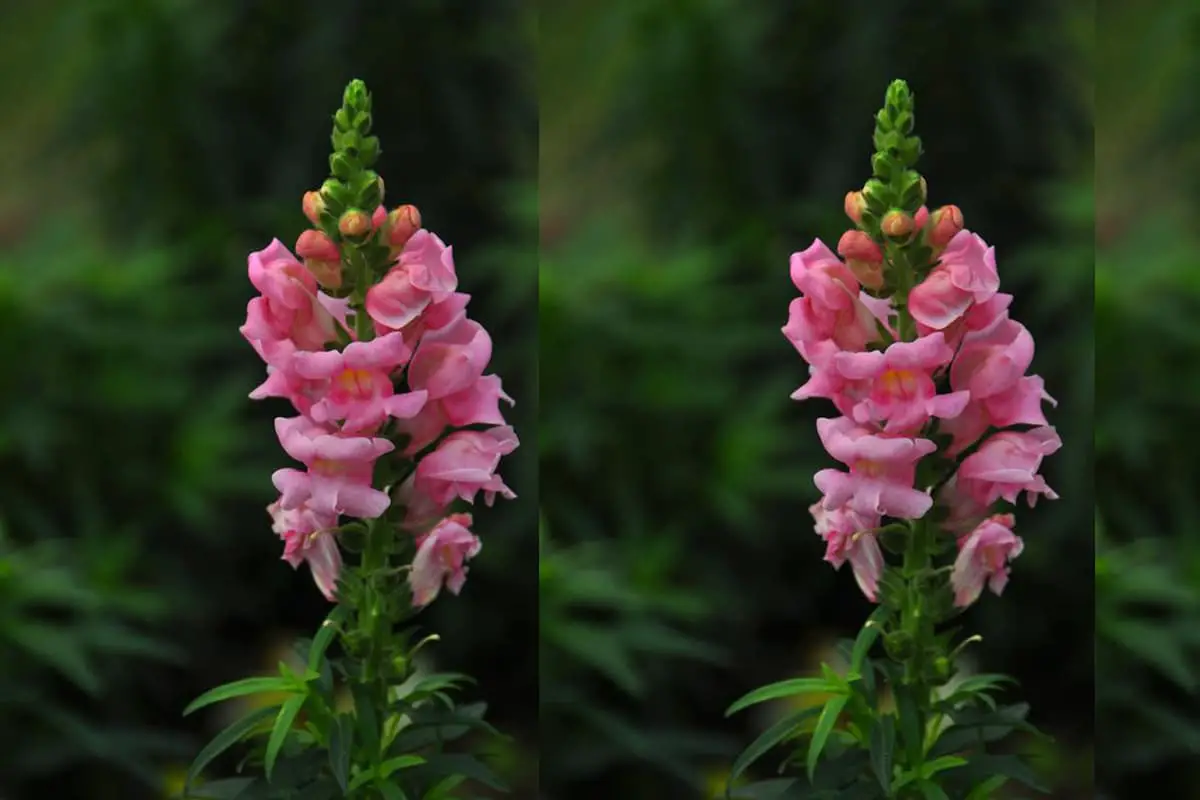
Antirrhinum majus, commonly known as the snapdragon, is a versatile herbaceous plant belonging to the Plantaginaceae family. This species typically grows between 20 and 70 centimeters in height, with some cultivars reaching up to 1 meter tall.
The plant’s stem base may become woody with age and often branches, creating a bushy appearance. Its leaves are arranged alternately along the stem, featuring a short petiole and an oval-lanceolate shape. The foliage is dark green and slightly glossy, providing an attractive backdrop for the flowers.
Snapdragon flowers are distinctive for their tubular, bilabiate (two-lipped) structure. The corolla is slightly swollen at the base, forming a pouch-like structure. The upper lip consists of two lobes that stand erect, while the lower lip has three lobes that curve outward. When gently squeezed, the flower opens and closes in a manner reminiscent of a dragon’s mouth, hence its common name.
The blooms of A. majus come in a wide spectrum of colors, including pure white, various shades of pink, deep crimson, salmon, yellow, and orange. Many cultivars also feature bicolor patterns or delicate veining. The diverse color palette and unique flower shape have led to comparisons with goldfish, contributing to its ornamental appeal.
Flowering occurs from late spring through early fall, typically peaking between July and October. In mild climates, snapdragons may bloom nearly year-round.
Native to the Mediterranean region and North Africa, A. majus has a natural distribution that extends from Morocco and Portugal in the west to Turkey and Syria in the east. It has been widely cultivated and naturalized in many temperate regions worldwide.
Snapdragons prefer full sun but can tolerate partial shade, especially in hotter climates. They thrive in cool temperatures and are notably cold-hardy, often surviving light frosts. However, they are sensitive to extreme heat, which can cause flower drop and reduced blooming.
The ideal growing medium for snapdragons is a well-draining, fertile soil with a pH between 6.2 and 7.0. They can tolerate slightly alkaline conditions but may suffer from chlorosis in highly calcareous soils.
Propagation is primarily achieved through seed sowing, although stem cuttings can be successful for specific cultivars. Seeds are typically sown indoors 6-8 weeks before the last frost date and transplanted outdoors after hardening off.
In horticultural applications, snapdragons are incredibly versatile. Dwarf varieties, ranging from 15-30 cm, are excellent for edging, container gardens, and mass plantings in flower beds. Medium-height cultivars (30-60 cm) are perfect for mixed borders and cut flower gardens. Tall varieties (60-100 cm) make striking vertical accents and are prized for cut flower production.
Beyond ornamental uses, A. majus has several practical applications. The venation pattern in its leaves has been studied as a potential bioindicator for atmospheric chlorine levels. The seeds contain an oil that can be extracted for industrial uses.
Medicinally, the entire plant has been traditionally used in some cultures for its anti-inflammatory and cooling properties, although scientific validation of these uses is limited.
In the language of flowers, snapdragons carry various symbolic meanings. They are often associated with grace, strength, and resilience due to their ability to grow in challenging conditions. Different flower colors convey distinct messages: white for purity, pink for affection, red for passion, and yellow for joy and energy.
As garden plants, snapdragons offer long-lasting color, attract pollinators such as bumblebees, and provide vertical interest in diverse landscape designs. Their ability to self-seed in favorable conditions can lead to charming naturalized patches in gardens, ensuring their continued presence and enjoyment for years to come.
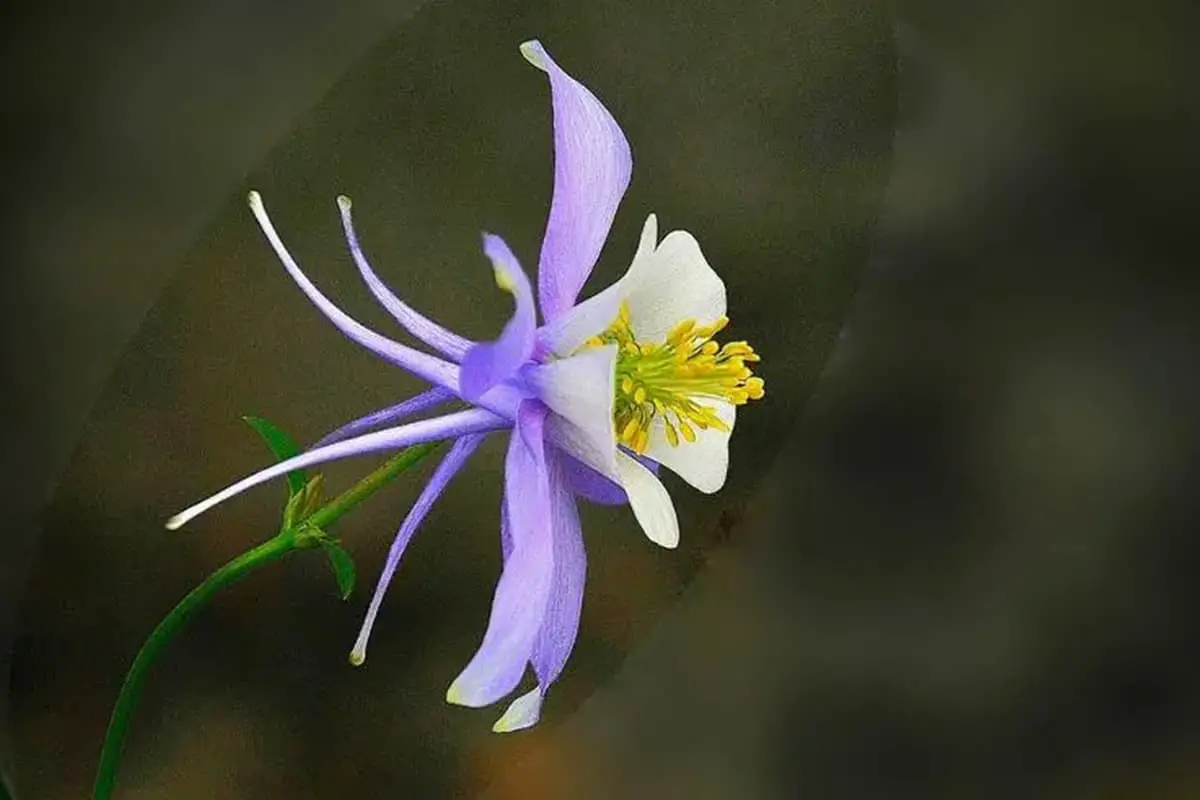
Aquilegia yabeana, commonly known as the Northern Chinese Columbine, is a captivating perennial herb belonging to the Ranunculaceae family. This elegant species boasts a robust cylindrical root system and erect stems that can ascend to heights of 60 centimeters, with characteristic branching near the apex.
The plant’s foliage is distinctive, with numerous basal leaves supported by elongated petioles. The leaf blades are compact, exhibiting a rhombic to ovate or broadly rhombic shape. These leaves are triternate, with crenate margins adorning each leaflet. The adaxial surface is glabrous, while the abaxial side bears a fine indumentum of short, soft trichomes. Cauline leaves feature slightly extended petioles and typically display a bipinnate trifoliate arrangement.
The inflorescence of A. yabeana is composed of a few flowers, each subtly adorned with short glandular hairs. Bracts may be tripartite or simple, assuming a narrowly ovate form. The nodding flowers are a hallmark of the species, with sepals presenting a striking purple hue and a narrowly ovate shape. The corolla echoes this purple coloration in its petals, creating a harmonious floral display. The ovary is densely covered with short glandular trichomes, a feature that persists through fruit development.
Flowering occurs from May to June, culminating in the production of small, black seeds that are narrowly ovate-spherical in shape. This phenological timing aligns with the warming temperatures and increased daylight of late spring and early summer in its native habitats.
A. yabeana is endemic to China, thriving on montane grassland slopes and in proximity to forest edges. Its natural distribution reflects its adaptability to cooler climates and specific soil conditions. The species exhibits notable cold hardiness and demonstrates a preference for semi-shaded locations with consistent moisture. Optimal growth is achieved in well-draining sandy loam soils, which provide the ideal balance of water retention and aeration for its root system.
Beyond its ornamental value, A. yabeana possesses interesting biochemical properties. The roots contain appreciable quantities of carbohydrates, which can be extracted to produce syrup or serve as a substrate for alcohol fermentation. Additionally, the seeds yield an oil that has potential applications in various industrial processes.
In cultivation, gardeners and horticulturists can replicate the plant’s natural preferences by providing partial shade, regular but not excessive moisture, and rich, well-draining soil. These conditions will encourage robust growth and abundant flowering, allowing this charming Chinese native to showcase its full potential in garden settings.
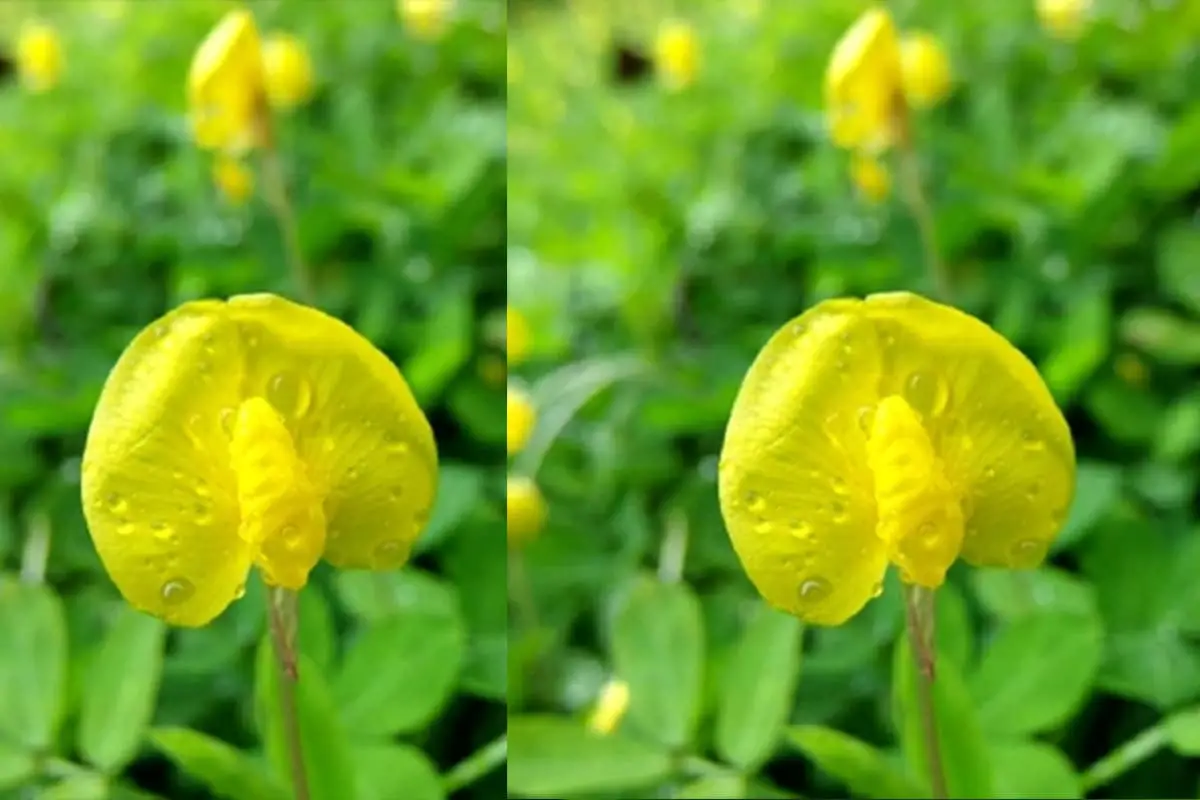
Arachis duranensis, commonly known as the wild peanut, is a species of legume in the Fabaceae family. It is one of the diploid ancestors of the cultivated peanut (Arachis hypogaea) and plays a crucial role in peanut breeding programs. Unlike the description provided, A. duranensis is not typically referred to as “creeping peanut” or “vine peanut,” as these terms are more commonly associated with other species.
Native to South America, particularly Bolivia and Argentina, A. duranensis is an annual or short-lived perennial herb. It grows as a prostrate or semi-erect plant, typically reaching heights of 20-50 centimeters. The stems are slender and covered with fine hairs.
The leaves are alternate and compound, consisting of four leaflets arranged in two pairs. Each leaflet is obovate to elliptical in shape, with entire margins and a slightly hairy surface. The foliage has a characteristic blue-green color.
Flowers of A. duranensis are typical of the Fabaceae family, with a papilionaceous (butterfly-like) structure. They are small, approximately 1-1.5 cm in diameter, and bright yellow in color. Flowering usually occurs during the warmer months, with the exact timing varying depending on local climate conditions.
After pollination, the plant produces fruits known as pods. These develop underground through a process called geocarpy, where the fertilized ovary grows downward and buries itself in the soil. The pods are small, typically containing one or two seeds.
A. duranensis thrives in well-drained, sandy or sandy loam soils. It is adapted to tropical and subtropical climates, with optimal growing temperatures ranging from 25°C to 35°C. The plant has good drought tolerance but is sensitive to frost.
Propagation of A. duranensis is primarily through seeds. In its natural habitat, the plant reproduces by self-seeding. For research and breeding purposes, careful hand pollination and seed collection are often necessary.
The significance of A. duranensis lies in its genetic contribution to cultivated peanuts. It is one of the diploid progenitors that, through hybridization with another wild species (likely Arachis ipaensis), gave rise to the tetraploid cultivated peanut. This makes A. duranensis invaluable in peanut improvement programs, particularly for introducing traits such as disease resistance and stress tolerance into commercial varieties.
While A. duranensis itself is not typically used for erosion control or as a cover crop, some of its cultivated relatives and other Arachis species are employed for these purposes. Similarly, its potential for air purification or use as animal fodder is limited compared to cultivated peanut varieties.
In conclusion, Arachis duranensis is a wild peanut species of immense importance in agricultural research and peanut breeding. Its unique characteristics and genetic makeup continue to play a crucial role in the development of improved peanut cultivars worldwide.
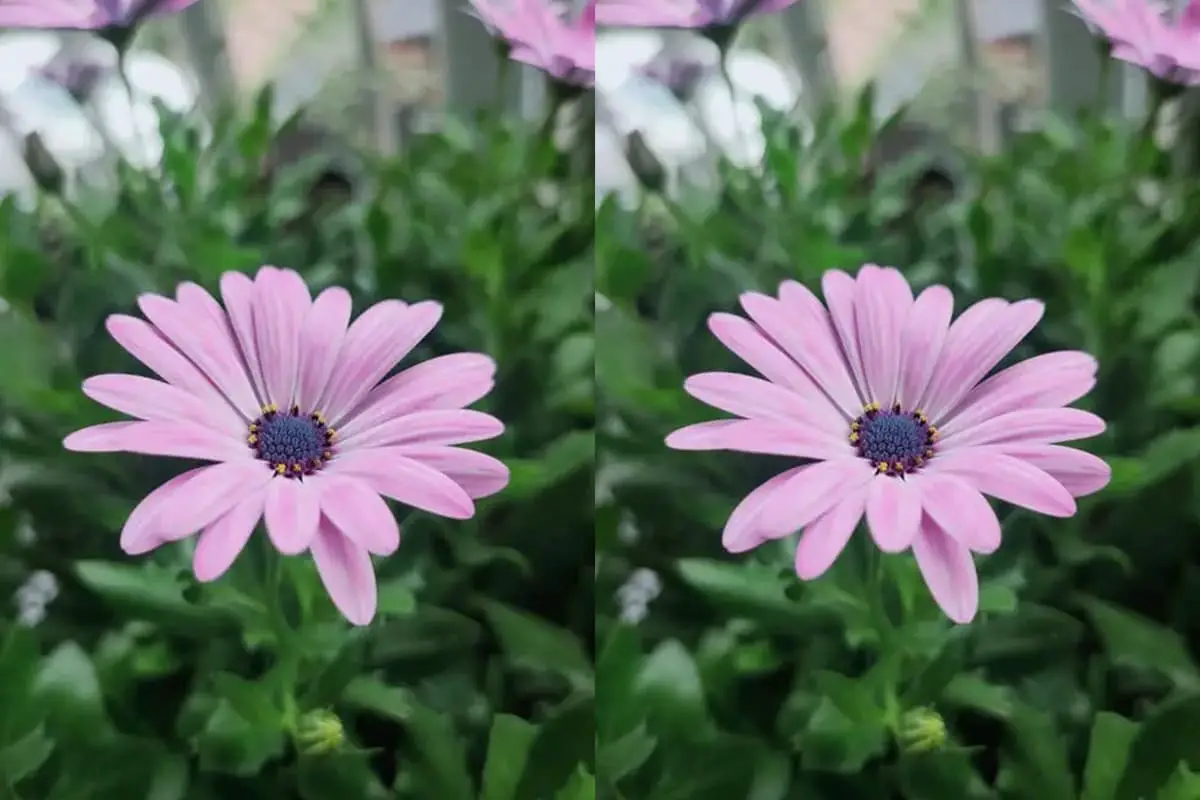
The Arctotis stoechadifolia, commonly known as the blue-eyed African daisy or African bush daisy, is a striking perennial plant native to South Africa. Typically growing to a height of 30-60 cm (1-2 feet), this member of the Asteraceae family showcases a compact, spreading habit that makes it an excellent choice for borders, rock gardens, and container plantings.
The foliage of A. stoechadifolia is highly distinctive. Basal leaves form a rosette, while stem leaves are arranged alternately along the stems. The leaves are elongated oval to ovate in shape, often deeply pinnately lobed, with margins that can be entire or slightly serrated.
A notable characteristic is the presence of white, downy hairs covering the leaf surface, particularly prominent on young growth. This pubescence not only gives the plant a silvery-green appearance but also helps it conserve water in its native arid habitats.
The flowers of A. stoechadifolia are its most captivating feature, measuring approximately 7.5 cm (3 inches) in diameter. Each daisy-like flower head consists of ray florets and disc florets. The ray florets (often mistaken for petals) are white on the upper surface, with a subtle lavender or pale purple underside, and typically have pointed tips. The central disc is a striking blue-purple, giving rise to the common name “blue-eyed” African daisy. This unique color combination makes the flowers particularly eye-catching in the garden.
As a plant adapted to the South African climate, A. stoechadifolia has specific growing requirements. It thrives in full sun exposure, which promotes abundant flowering and compact growth. The ideal temperature range for optimal growth and blooming is between 18°C and 26°C (64°F to 79°F). It’s important to note that this species is sensitive to both cold and excessive heat. In regions with harsh winters, it’s often grown as an annual or overwintered indoors.
Well-draining soil is crucial for the health of A. stoechadifolia. In its natural habitat, it’s accustomed to sandy or gravelly soils that don’t retain excess moisture. In cultivation, a loamy soil mix with added grit or perlite can mimic these conditions. While the plant is relatively drought-tolerant once established, regular watering during the growing season will promote lush growth and prolific flowering.
Although A. stoechadifolia is technically a perennial in its native range and in USDA zones 9-11, many gardeners in cooler climates treat it as an annual. This approach allows them to enjoy its beautiful blooms during the summer months without the challenge of winter protection. When grown as a perennial, it may be cut back in late winter to encourage fresh growth in spring.
The blue-eyed African daisy is not only ornamental but also attracts pollinators, making it a valuable addition to wildlife-friendly gardens. Its long flowering period, typically from late spring through autumn, provides a consistent source of nectar for bees and butterflies.
In conclusion, Arctotis stoechadifolia is a versatile and attractive plant that brings a touch of South African beauty to gardens worldwide. Its unique flowers, interesting foliage, and adaptable nature make it a favorite among gardeners looking to add diversity and color to their outdoor spaces.

The Ariocarpus fissuratus, commonly known as the “Living Rock Cactus” or “False Peyote,” is a remarkable member of the Cactaceae family. This slow-growing, stemless succulent is native to the Chihuahuan Desert regions of southwestern Texas, USA, and northern Mexico.
The plant’s unique morphology consists of a flattened, disc-shaped body that rarely exceeds 15 cm (6 inches) in diameter. Its body is composed of triangular, overlapping tubercles arranged in a spiral pattern, giving it a rosette-like appearance. The tubercles are grayish-green to brownish in color, with a rough, fissured surface that closely mimics the surrounding limestone rocks, hence its common name.
Between the tubercles, areoles produce fine, woolly trichomes, which serve to protect the plant from extreme sun exposure and aid in moisture retention. The apex of the plant often appears slightly depressed and woolly.
Ariocarpus fissuratus typically blooms in late autumn, producing striking flowers that emerge from the center of the plant. The flowers are relatively large for the size of the plant, reaching up to 4 cm (1.6 inches) in diameter. They range in color from pale pink to magenta, with multiple petals arranged in a funnel shape. Flowering is generally triggered by cooler temperatures and shorter day lengths.
After successful pollination, the plant produces small, oval-shaped fruits that are green and fleshy, containing numerous small, black seeds. These fruits often remain hidden between the tubercles until they dry and split open to release the seeds.
In its natural habitat, Ariocarpus fissuratus grows in well-draining, calcareous soils with high mineral content. It’s adapted to survive extreme heat and drought conditions, often retracting into the ground during dry periods. The plant is frost-hardy to about -10°C (14°F) when kept dry, but it prefers warmer temperatures for optimal growth.
Cultivation of Ariocarpus fissuratus is challenging and requires expert care. It demands very well-draining substrate, minimal watering, and protection from excess moisture, especially during its winter dormancy period. Propagation is primarily done through seeds, as the plant rarely produces offsets. Seedlings grow extremely slowly, often taking several years to reach flowering size.
Due to its slow growth rate and specific habitat requirements, Ariocarpus fissuratus is considered vulnerable in the wild. It’s protected under CITES Appendix I, making international trade of wild-collected specimens illegal. Conservation efforts focus on habitat protection and controlled propagation in specialized nurseries.
In cultivation, this species is highly prized by cactus enthusiasts for its unique appearance and rarity. It’s primarily grown by collectors and botanical institutions, where it serves as an excellent example of plant adaptation to extreme environments. Its cultivation not only preserves this remarkable species but also reduces collection pressure on wild populations.

The Aristolochia gigantea, commonly known as the “Giant Pelican Flower” or “Brazilian Dutchman’s Pipe,” is a striking evergreen woody vine belonging to the Aristolochiaceae family. This tropical climber is renowned for its spectacular, oversized flowers and vigorous growth habit.
Morphology:
The plant exhibits dimorphic stem characteristics: mature stems are rough-textured and angular, while young growth is smooth and glabrous. The leaves are alternately arranged, featuring an ovate-cordate shape with entire margins. Each leaf has a short, acuminate apex and a distinctly cordate base, attached to the stem by a petiole.
Flowers:
The most remarkable feature of A. gigantea is its solitary, axillary flowers. These extraordinary blooms can reach up to 30 cm in diameter and are adorned with intricate purplish-brown spots or striations on a lighter background.
The flower’s structure is particularly fascinating, consisting of a single modified petal (perianth) that forms a deep pouch reminiscent of a pelican’s throat sac, hence its common name. The flowering period typically extends from June to November, with peak blooming in late summer.
Origin and Cultural Requirements:
Native to the tropical regions of Brazil, A. gigantea thrives in warm, humid environments. It prefers temperatures between 22°C to 28°C (72°F to 82°F) and is not cold-hardy, being sensitive to temperatures below 10°C (50°F). While it flourishes in full sun, it can tolerate partial shade, especially in hotter climates.
The ideal growing medium for A. gigantea is a well-draining, fertile loam soil rich in organic matter. Regular watering is essential during the growing season, but the soil should never become waterlogged. High humidity is beneficial for optimal growth and flowering.
Propagation:
Seed propagation is the most common method for reproducing A. gigantea. Seeds should be sown fresh, as they lose viability quickly. Alternatively, stem cuttings can be used for vegetative propagation, though this method is less reliable.
Landscape Use:
The Giant Pelican Flower’s impressive size and unique floral display make it an excellent choice for various landscape applications:
When cultivating A. gigantea, it’s important to provide strong support structures due to its vigorous growth. Regular pruning may be necessary to control its size and shape, especially in confined spaces.
Note: While visually stunning, all parts of A. gigantea are toxic if ingested, containing aristolochic acid. Care should be taken when planting in areas accessible to children or pets. Additionally, the flowers emit a strong, sometimes unpleasant odor to attract pollinators, which may be a consideration in some landscape settings.

Armeniaca mume, commonly known as the Chinese plum or Japanese apricot, is a member of the Rosaceae family and Prunus genus. This small tree or shrub typically grows 4-10 meters tall, featuring smooth, light gray or greenish bark and hairless green young branches.
The leaves are ovate or elliptical with finely serrated edges and a grayish-green color. Flowers, measuring 2-2.5 cm in diameter, bloom solitarily or in pairs before the leaves appear, emitting a strong fragrance. The calyx is usually reddish-brown, though some varieties may have green or greenish-purple calyces. Petals are ovate and range from white to pink.
The fruit is yellow or greenish-white, 2-3 cm in diameter, covered in soft hair, and has a sour taste. Its flesh adheres to the elliptical, slightly flattened seed. Flowering occurs in winter and early spring, with fruit ripening from May to June.
Native to Central and Southern China and Northern Indochina, Armeniaca mume thrives in temperate climates. It is widely cultivated for ornamental purposes, including as potted plants and decorative ‘plum posts’. The species has various uses:
In Chinese culture, the plum blossom holds significant importance:
The tree’s ornamental value is particularly high when cultivated as bonsai or in gardens, with its pristine white flowers contrasting against ancient-looking branches during late winter or early spring.
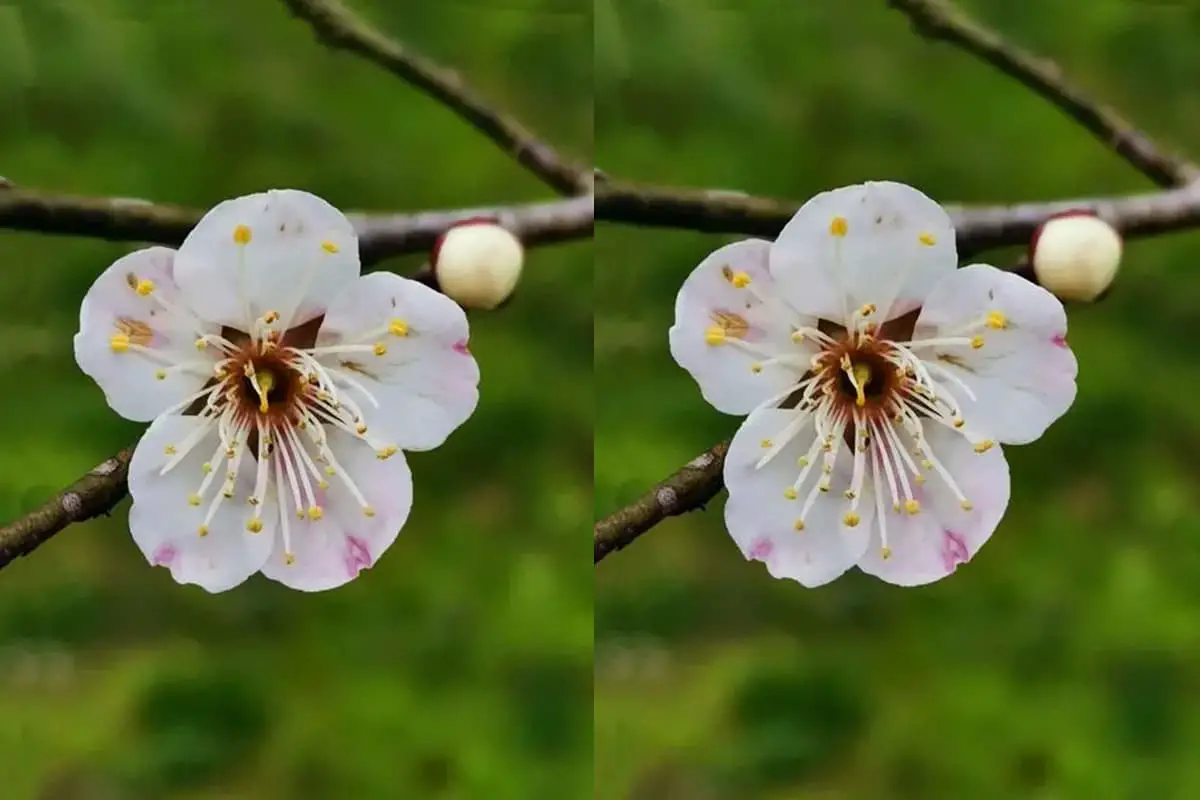
Armeniaca mume Sieb., commonly known as Japanese apricot or ume, is a species within the Prunus genus, closely related to both apricots and plums. This ornamental tree is highly valued for its early-blooming flowers and cultural significance in East Asian countries.
The Japanese apricot is renowned for its diverse flower patterns and colors. Blossoms can be single, semi-double, or double-petaled, with sizes ranging from 2 to 2.5 cm in diameter. While the primary color is often white, many cultivars exhibit a stunning array of hues, including pink, red, and bicolor variations.
The white flowers are frequently adorned with red streaks or spots, creating a delicate and eye-catching appearance. Occasionally, within a cluster of white blossoms, a few red petals or even entirely red flowers may emerge, adding to the tree’s visual appeal and uniqueness.
Armeniaca mume typically grows with a compact branch structure, making it an excellent choice for bonsai cultivation and ornamental landscaping. The dense growth habit of the flowers, coupled with their early blooming period (often in late winter to early spring), makes this species particularly prized in garden design and cut flower arrangements.
The tree’s adaptability to various pruning techniques allows it to be shaped into different forms, from small bonsai specimens to larger landscape trees. When used in cut flower arrangements, the branches showcase the beauty of the blossoms while providing a sculptural element with their naturally graceful form.
Beyond its ornamental value, Armeniaca mume has significant cultural importance, particularly in Japan, China, and Korea. The fruit, although not typically eaten fresh due to its high acidity, is often used to make umeboshi (pickled plums) and other traditional preserves. The blossoms are also celebrated in art, literature, and seasonal festivals throughout East Asia.
In cultivation, Japanese apricot thrives in well-drained, slightly acidic soil and prefers full sun to partial shade. Its hardiness and early blooming nature make it a valuable addition to gardens, providing color and interest when many other plants are still dormant.
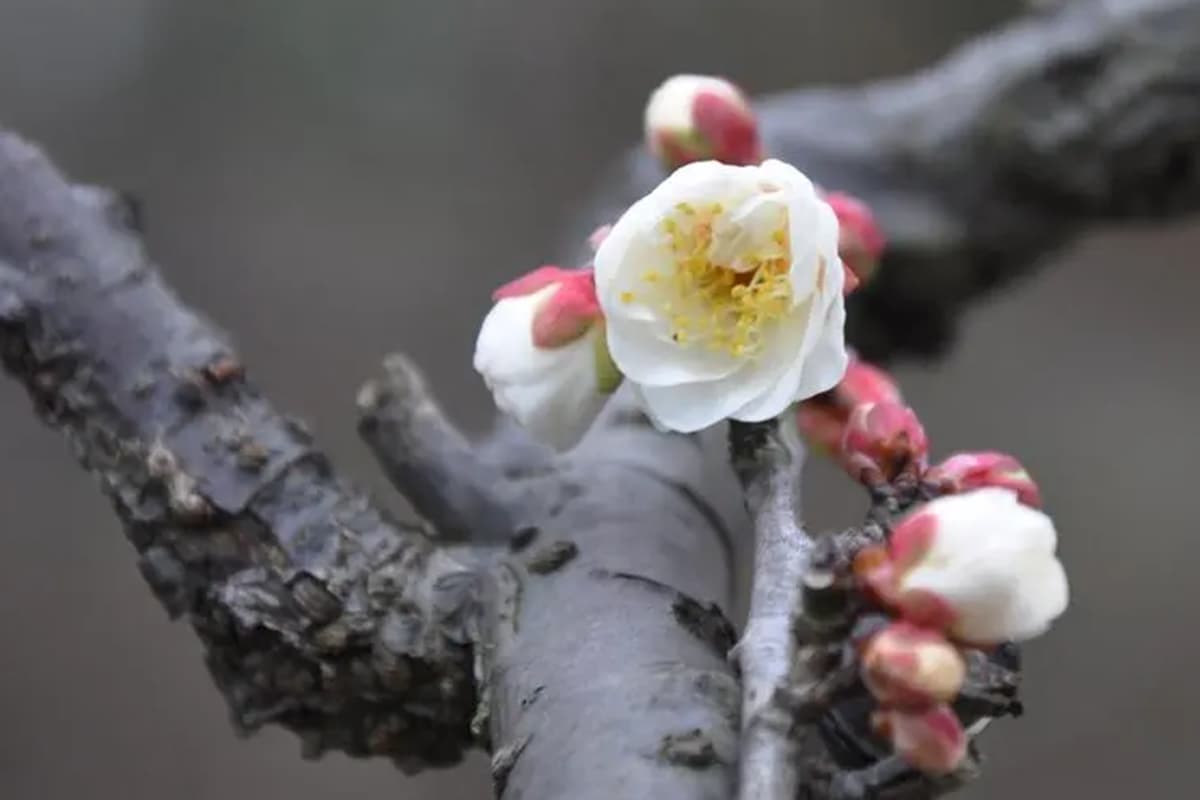
Armeniaca mume ‘Tortuosa’, commonly known as the “Dragon Twisting Plum” or “Contorted Japanese Apricot,” is a distinctive cultivar of the Japanese apricot (Prunus mume) from the Rosaceae family. This ornamental tree is prized for its unique growth habit and delicate winter blooms.
The most striking feature of the Dragon Twisting Plum is its intricately contorted branches, which twist and turn in a serpentine manner, creating a sculptural silhouette reminiscent of a writhing dragon. This natural architectural form provides year-round visual interest, particularly when the tree is bare in winter.
In late winter to early spring, before the leaves emerge, the tree produces an abundance of fragrant flowers. These blossoms are typically 2-3 cm in diameter, with 5 petals arranged in a simple, elegant form. While the most common flower color is white, some varieties may exhibit pale pink hues. The flowers emit a sweet, almond-like fragrance that perfumes the air, adding to the sensory appeal of this cultivar.
The Dragon Twisting Plum is highly valued in East Asian horticulture, particularly in the art of bonsai. Its naturally contorted form lends itself well to this miniature tree cultivation technique, allowing practitioners to create living sculptures that embody the essence of aged, windswept trees in nature.
Within the Prunus mume species, there are several cultivars categorized by their growth habits:
The ‘Tortuosa’ cultivar, our Dragon Twisting Plum, is considered a rarity among Japanese apricots due to its unique branch structure. While there are several contorted cultivars of other Prunus species (such as P. persica ‘Contorta’), the twisted form is less common in P. mume.
In cultivation, the Dragon Twisting Plum prefers full sun to partial shade and well-drained, slightly acidic soil. It is relatively hardy, typically thriving in USDA zones 6-9. The tree reaches a mature height of 4-6 meters (13-20 feet) with a similar spread, making it suitable for smaller gardens or as a focal point in larger landscapes.
Pruning should be done with care to maintain the tree’s natural twisted form while promoting health and vigor. It’s best to prune immediately after flowering to avoid removing next year’s flower buds.
While primarily grown for ornamental purposes, the fruit of Armeniaca mume ‘Tortuosa’ is edible, though often too sour for fresh consumption. In East Asian cuisine, these fruits are sometimes used to make preserves or flavored liquors.
The Dragon Twisting Plum serves as a living testament to the diversity and beauty within the Prunus genus, offering gardeners and plant enthusiasts a truly unique specimen that combines graceful flowers, enchanting fragrance, and captivating form in one remarkable package.
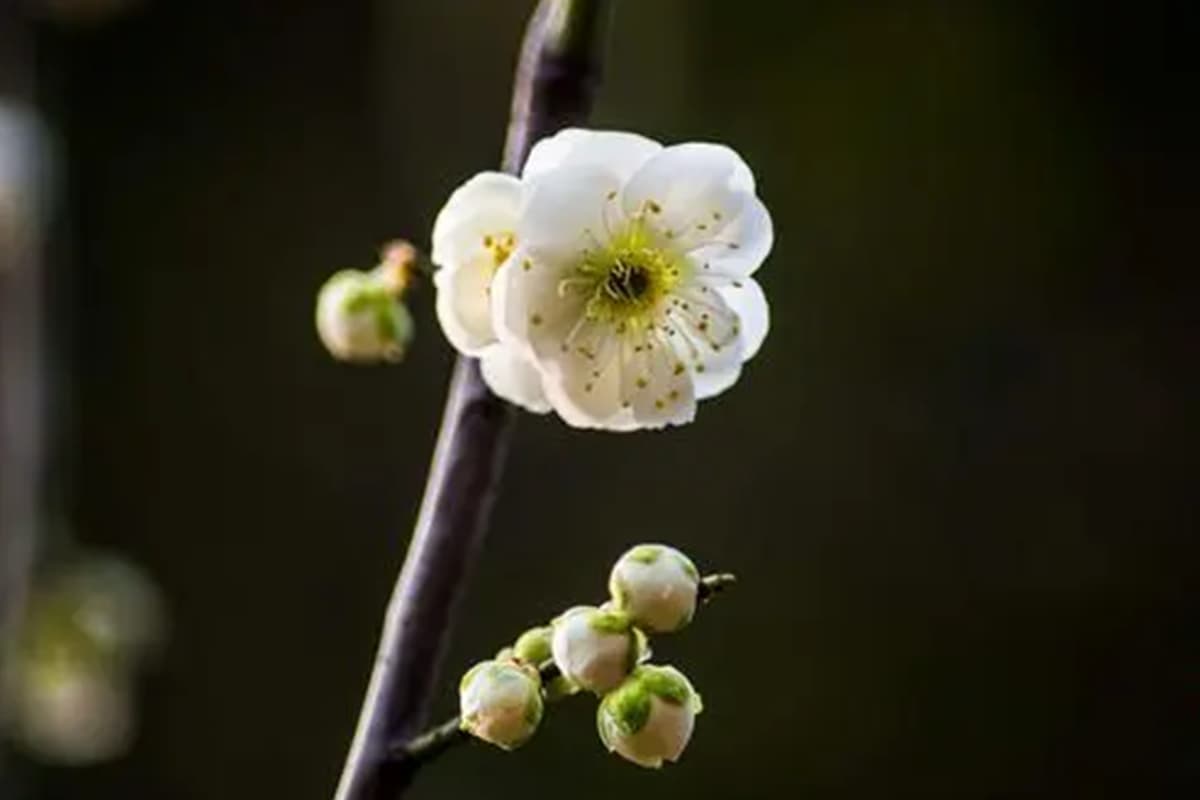
Armeniaca mume Sieb. et Zucc., commonly known as “Green Calyx Plum” or Japanese apricot, is a small deciduous tree typically growing between 4 to 10 meters tall. Its bark is light gray or occasionally greenish, with a smooth texture. The young branches are green and glabrous.
The leaves are ovate to elliptical, measuring 4-8 cm long and 2.5-5 cm wide, with finely serrated margins. They are grayish-green in color, with a slightly glossy upper surface and paler underside. The foliage emerges after the flowers, a characteristic known as hysteranthous.
The flowers are precocious, blooming in late winter to early spring before the leaves appear. They can be solitary or occasionally paired, arising from the same bud. The blossoms are strongly fragrant, with a rich, sweet scent that carries well in the cool air.
The flower stalks (pedicels) are short, typically 2-5 mm long. The calyx is distinctively green, giving rise to the common name “Green Calyx Plum.” The petals are suborbicular to broadly obovate, pure white in color, and measure 1-2 cm in diameter.
Depending on the cultivar, the flowers can be single (5 petals), semi-double (6-10 petals), or double (more than 10 petals). The green calyx is campanulate (bell-shaped) and broad, while the calyx lobes are ovate to suborbicular with obtuse tips.
This species is highly esteemed in East Asian horticulture and is often described as the most refined or “gentlemanly” among plums. Several cultivars exist, including ‘Daqing Lüe’ (Large Flower Green Calyx), ‘Danban Lüe’ (Single Petal Green Calyx), and ‘Jinye Lüe’ (Brocade Leaf Green Calyx).
The fruit is a drupe, nearly spherical in shape, 2-3 cm in diameter. It is typically green when unripe, turning yellow with a reddish blush when mature. The flowering period is from January to March, depending on the climate, with fruits ripening from May to June.
Armeniaca mume is widely cultivated for ornamental purposes in gardens, parks, and as bonsai. It is particularly valued for its early bloom, which provides color and fragrance in the late winter landscape.
In addition to its ornamental use, various parts of the tree, including the fruit, seeds, and bark, have applications in traditional Chinese medicine. The fruit is also used in East Asian cuisine, often pickled or preserved, and is a key ingredient in the production of umeshu, a Japanese liqueur.
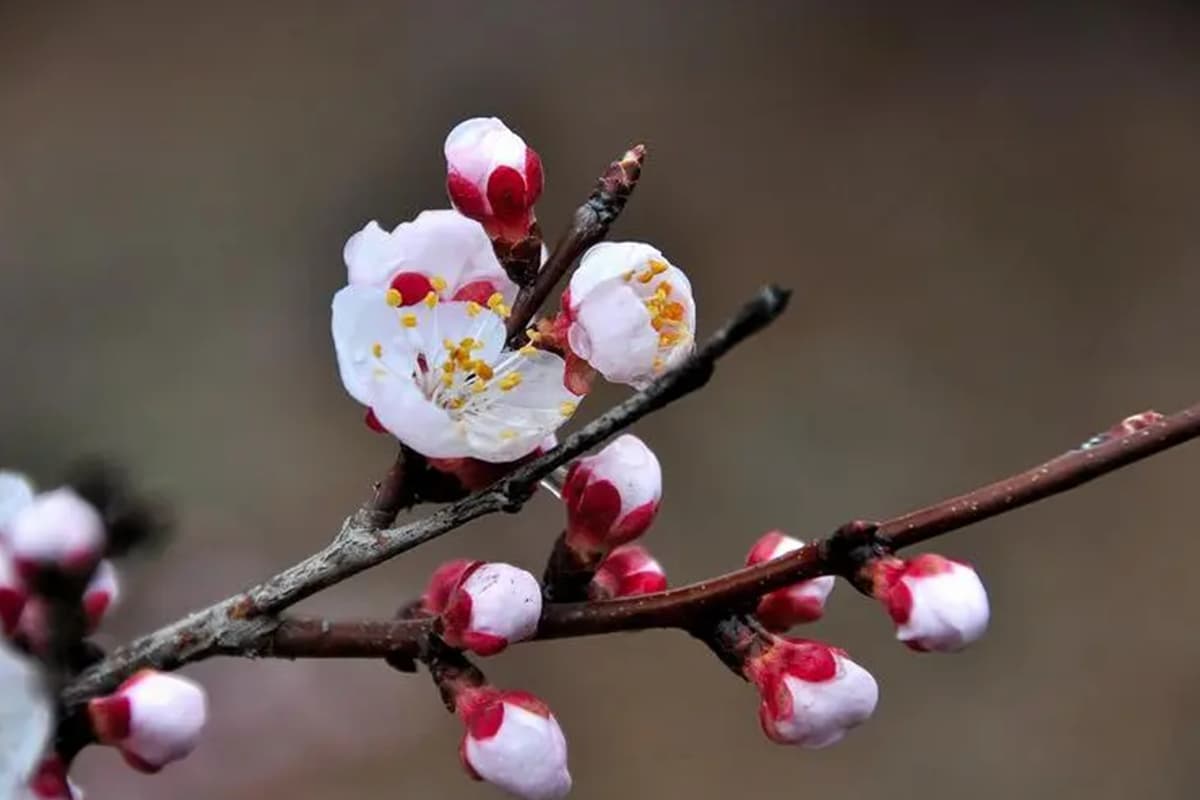
Armeniaca vulgaris, commonly known as the apricot tree, belongs to the Rosaceae family and Prunus genus. Its flowers, often referred to as apricot blossoms, are not only aesthetically pleasing but also hold cultural and medicinal significance.
The apricot tree is a deciduous species that can reach heights of over 10 meters. It features an upright stem with branches that spread slightly upward. The young branches exhibit a distinctive brown or reddish-brown coloration. The leaves are characterized by their short stalks and rounded shape, typically with serrated edges.
When in bloom, apricot blossoms showcase delicate petals that are primarily white or pale pink, sometimes with a hint of red. The flowers are usually perfect, containing both male and female reproductive parts, with numerous stamens surrounding a single pistil. This floral structure promotes both self-pollination and cross-pollination, often facilitated by insects.
The fruit of Armeniaca vulgaris is a drupe, spherical in shape and slightly flattened on both sides, with a characteristic longitudinal groove. The fruit’s exterior is covered in fine, velvety hairs and typically measures 2-4 cm in diameter. As the fruit matures from May to June, its color transitions from green to yellow or yellow-orange, often developing a reddish blush on the sun-exposed side.
Native to China, apricot trees have adapted to temperate and subtropical regions of North Asia. They thrive in areas with long daylight hours and moderate sunlight exposure. Optimal growing conditions include warm, moist climates with well-drained soils. Apricot trees are relatively cold-hardy but can be susceptible to late spring frosts, which can damage the blossoms and reduce fruit yield.
The tree’s growth cycle is closely tied to temperature. Bud break and flowering typically occur when spring temperatures consistently reach 10-15°C (50-59°F). This temperature sensitivity makes apricots one of the earliest stone fruits to bloom in spring, often preceding peaches and plums.
Propagation of apricot trees can be achieved through various methods. While seed propagation is common, it may not produce trees true to the parent variety due to genetic variability. For commercial production and to maintain desirable traits, vegetative propagation methods such as grafting, budding, or cutting are preferred. These techniques ensure genetic consistency and can also improve disease resistance or cold hardiness by using appropriate rootstocks.
Apricot blossoms have been traditionally used in Chinese medicine and cosmetics. The flowers contain various bioactive compounds, including flavonoids and phenolic acids, which contribute to their potential health benefits. Regular application of apricot blossom water to the face is believed to help improve skin texture and reduce blemishes, though scientific evidence for these claims is limited.
The blossoms and fruit are sources of vitamins A, C, and E, as well as potassium and other minerals. These nutrients may contribute to maintaining healthy blood pressure and supporting overall cardiovascular health. However, it’s important to note that individuals with certain health conditions, particularly those prone to coughing or diarrhea, should exercise caution when consuming apricot products, as they may exacerbate these symptoms in some cases.
Beyond their practical uses, apricot blossoms hold cultural significance in various regions. In Jiamusi, a city in Heilongjiang Province, China, the apricot blossom serves as the official city flower. This designation highlights the tree’s ornamental value and its importance in urban greening initiatives.
In conclusion, Armeniaca vulgaris is a versatile and valuable species, prized for its beautiful blossoms, nutritious fruit, and cultural significance. Its cultivation and appreciation span millennia, making it an important part of horticultural heritage and modern agriculture alike.
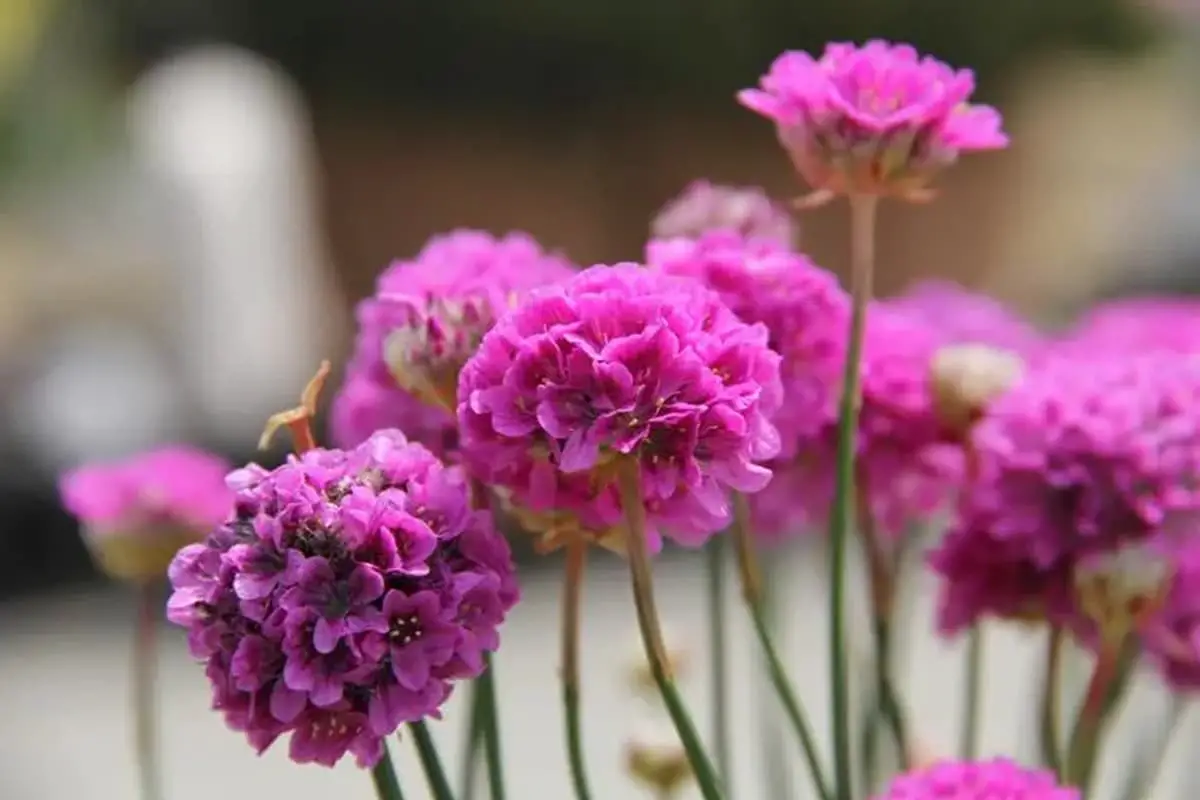
Armeria maritima, commonly known as Thrift or Sea Pink, is a charming herbaceous perennial belonging to the Plumbaginaceae family. This compact plant forms dense, mounded tufts of narrow, grass-like leaves, creating an attractive evergreen base from which slender flower stems emerge.
The foliage consists of linear, dark green leaves that grow in tight rosettes, typically reaching 10-15 cm (4-6 inches) in height. In late spring to early summer, usually from May to July, sturdy stems rise 15-30 cm (6-12 inches) above the foliage, each crowned with a globular inflorescence.
These distinctive flower heads, measuring 2-3 cm (0.8-1.2 inches) in diameter, comprise numerous small, funnel-shaped flowers tightly packed together. While pink is the most common color, cultivars offer a range of hues from white to deep rose and even purple. The blooms are not only visually appealing but also attract pollinators, particularly bees and butterflies.
Armeria maritima is native to coastal regions of Europe, including the British Isles, as well as parts of North and South America. Its natural habitat includes clifftops, salt marshes, and coastal grasslands, which explains its remarkable adaptability to challenging conditions.
This hardy plant thrives in full sun to partial shade and prefers well-draining, sandy or gravelly soils. It demonstrates exceptional tolerance to drought, salt spray, and poor soil conditions, making it an ideal choice for coastal gardens or rock gardens. However, it’s important to note that while it can withstand brief periods of waterlogging, it does not tolerate consistently wet soils.
Propagation of Armeria maritima can be achieved through several methods. While seed sowing is common, division of mature clumps in spring or early autumn is often more reliable and produces flowering plants more quickly. Additionally, basal cuttings taken in late spring can be successfully rooted.
In garden design, Armeria maritima offers versatile applications. Its compact growth habit makes it excellent for edging paths or borders, while its ability to thrive in poor soils makes it ideal for rock gardens or gravel beds. In coastal landscapes, it provides a natural and low-maintenance ground cover.
For container gardening, Armeria maritima is an excellent choice. Its neat form and long-lasting flowers make it suitable for window boxes, patio containers, or as part of mixed plantings in larger pots. When grown in containers, ensure good drainage and avoid overwatering.
Beyond its ornamental value, Armeria maritima has historical uses in traditional medicine. Some coastal communities have used it to treat obesity and urinary tract disorders, although these applications require further scientific investigation.
In conclusion, Armeria maritima is a resilient and attractive plant that brings a touch of coastal charm to various garden settings. Its low-maintenance nature, coupled with its long flowering period and evergreen foliage, makes it a valuable addition to both home gardens and public landscapes.

Asclepias curassavica, commonly known as Tropical Milkweed or Bloodflower, is a striking perennial herbaceous plant belonging to the Apocynaceae family and the Asclepias genus. This versatile species typically grows to a height of 1-1.5 meters (3-5 feet), forming an upright, bushy habit.
The stem is slender and pale gray, with a smooth or slightly pubescent surface. Its leaves are opposite, simple, and lanceolate to oblong-lanceolate in shape, measuring 6-15 cm (2.4-5.9 inches) long and 1-4 cm (0.4-1.6 inches) wide. The foliage is deep green, glabrous on both sides or with minute hairs along the veins on the underside, and has a membranous texture.
The inflorescences are terminal or axillary umbels, each bearing 10-20 flowers. The flower stalks (pedicels) are finely pubescent, supporting the distinctive milkweed blooms. The calyx consists of five lanceolate lobes, while the corolla is comprised of five oblong petals that reflex backwards, revealing a prominent central corona. The flowers exhibit a striking color combination, with bright red or orange petals and a yellow corona, giving rise to its ‘Bloodflower’ moniker.
One of the most distinctive features of A. curassavica is its reproductive structures. The pollen is packaged into waxy masses called pollinia, which are purplish-red and paired between adjacent anthers. This unique pollination mechanism is characteristic of milkweeds and orchids. The fruit is a spindle-shaped follicle, 5-8 cm (2-3 inches) long, which splits when mature to release numerous flat, ovate seeds, each equipped with a tuft of silky hairs for wind dispersal.
Tropical Milkweed boasts an extended blooming period, flowering almost year-round in suitable climates, with peak bloom from late spring through fall. Fruit production typically occurs from August to December, though this can vary depending on local conditions.
Native to the Caribbean, Mexico, and parts of South America, A. curassavica has been widely cultivated and naturalized in tropical and subtropical regions worldwide, including parts of the southern United States, Southeast Asia, and even some Mediterranean areas. Its presence in Japan is likely due to introduction as an ornamental or medicinal plant.
This species thrives in full sun to partial shade and prefers warm, moist conditions. It demonstrates remarkable adaptability, tolerating a range of soil types and showing good drought resistance once established. While it can be propagated by division or stem cuttings, seed dispersal is its primary means of reproduction in the wild.
In traditional medicine, particularly in its native range and parts of Asia, the entire plant is utilized. It’s considered to have a bitter taste and a “cold” nature in traditional Chinese medicine (TCM) philosophy. The plant contains cardiac glycosides, making it toxic if ingested in large quantities. However, when used appropriately under professional guidance, it’s believed to possess several medicinal properties.
In TCM and other traditional healing systems, A. curassavica is used to clear heat, detoxify the body, activate blood circulation, stop bleeding, reduce swelling, and alleviate pain.
It’s traditionally employed to treat conditions such as lung heat-induced cough, sore throat, urinary tract infections, and menstrual irregularities. However, it’s crucial to note that its use in modern medicine is limited due to safety concerns, and further research is needed to validate these traditional uses.
Beyond its medicinal applications, Tropical Milkweed has gained popularity as an ornamental plant due to its vibrant flowers and long blooming period. It’s often used in butterfly gardens, as it’s a valuable nectar source for adult butterflies and a crucial host plant for monarch butterfly larvae. In landscape design, it can be planted in groups or as scattered specimens in parks, gardens, and naturalized areas, adding both color and ecological value to green spaces.
However, in some regions where it’s not native, there’s ongoing debate about its impact on monarch butterfly migration patterns. In these areas, gardeners are often advised to cut the plants back in late fall to mimic its natural life cycle and prevent potential negative effects on butterfly populations.

Aster hispidus, commonly known as the rough aster or hispid aster, is a species belonging to the Asteraceae family and the Aster genus. This herbaceous plant can be annual or biennial, featuring a vertically oriented, spindle-shaped root system.
The stems of Aster hispidus typically grow 30-50 cm tall, though they can occasionally reach heights of up to 150 cm. The plant exhibits a branching habit, with stems that are often hispid (covered in stiff, bristly hairs), hence its specific epithet.
Leaves are alternately arranged along the stem and are characterized by their thin texture. Both the upper and lower leaf surfaces are sparsely hairy to nearly glabrous (hairless), with scattered hairs along the leaf margins. The leaves display prominent midribs and lateral veins, contributing to their overall appearance.
The inflorescences of Aster hispidus are capitula (flower heads) measuring 3-5 cm in diameter. These are borne singly at the ends of branches, collectively forming an umbel-like arrangement. Each capitulum consists of two types of florets:
The flowering period for Aster hispidus extends from July to September, followed by fruiting from August to September. The fruit is an achene, ovate in shape, often with a pappus to aid in wind dispersal.
This species demonstrates adaptability to various habitats, thriving in disturbed areas such as wastelands and roadsides, as well as more natural settings like forest edges and grasslands. It has a wide altitudinal range, growing from lowlands up to elevations of 2400 meters above sea level. Geographically, Aster hispidus is distributed across the northern, northwestern, and northeastern provinces of China, as well as other parts of East Asia.
In traditional Chinese medicine, the root of Aster hispidus is valued for its medicinal properties. It is believed to possess detoxifying and anti-inflammatory effects, making it useful in treating various ailments including sores and snakebites. The plant’s ability to reduce swelling is particularly noted in traditional applications.
Beyond its medicinal uses, Aster hispidus holds ornamental value due to its large, bright flower heads. This makes it a potential candidate for cultivation in gardens or landscaping projects, particularly in areas that match its native growing conditions. Its attractive blooms can add color and interest to wildflower meadows, perennial borders, or naturalized areas in appropriate climates.
As with many Aster species, Aster hispidus plays an important ecological role by providing late-season nectar for pollinators, including bees and butterflies. This characteristic makes it a valuable addition to gardens focused on supporting local biodiversity and pollinator populations.
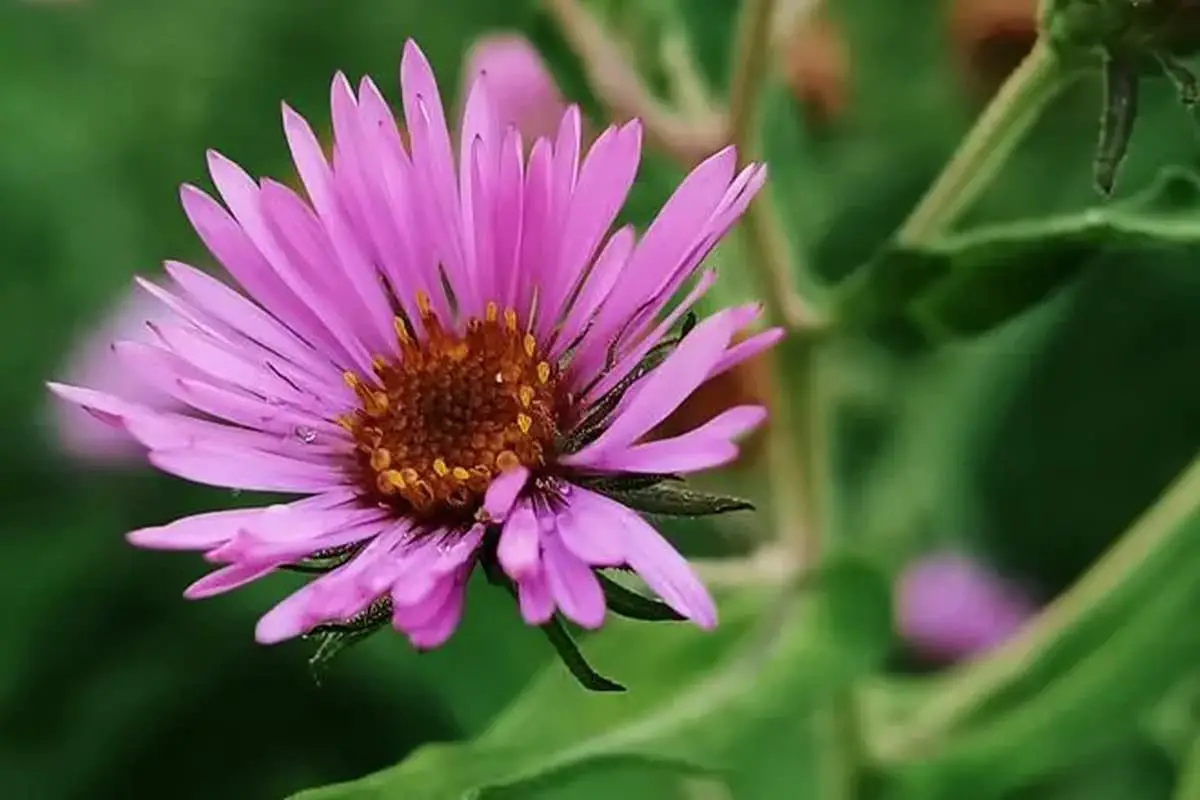
Aster novi-belgii, commonly known as New York aster or Michaelmas daisy, is a robust perennial herbaceous plant belonging to the Asteraceae family. This species can reach heights of up to 120 cm (4 feet), forming clumps that spread over time. The entire plant is characterized by a covering of coarse, short hairs, giving it a slightly rough texture.
The leaves of A. novi-belgii are arranged alternately along the stems and are narrowly lanceolate to linear-lanceolate in shape. They are typically 5-15 cm long and 0.5-2 cm wide, with entire or slightly toothed margins. The foliage is a deep green color, providing an attractive backdrop for the flowers.
The inflorescences of New York aster are composed of numerous flower heads arranged in a panicle or corymb-like structure. Each flower head (capitulum) consists of ray florets surrounding a central disc of tubular florets.
The ray florets, which give the appearance of petals, range in color from pale lavender to deep purple-blue, or occasionally white. The disc florets are usually yellow, turning reddish-brown as they mature. The involucral bracts, which enclose the base of each flower head, are linear and often have recurved tips.
A. novi-belgii typically blooms from late summer through autumn, generally from August to October in the Northern Hemisphere. This late-season flowering habit has earned it the name Michaelmas daisy in some regions, as it often flowers around the feast of St. Michael on September 29th.
Native to eastern North America, the New York aster has naturalized in many temperate regions of the Northern Hemisphere. It is particularly well-adapted to moist conditions but demonstrates remarkable versatility in its habitat preferences. The plant is drought-tolerant once established, cold-hardy (surviving in USDA zones 4-8), and can thrive in a variety of soil types, including poor soils.
For optimal growth and flowering, A. novi-belgii prefers full sun to partial shade and well-drained soil. While it can adapt to various soil conditions, it performs best in fertile, loose, sandy loam with a slightly acidic to neutral pH (6.0-7.0). Good air circulation is important to prevent fungal diseases, particularly in humid climates.
The New York aster’s bright colors, natural branching habit, and autumn blooming period make it a valuable addition to many garden settings. It is particularly popular in cottage gardens, wildflower meadows, and naturalistic planting schemes. In China, its flowering coincides with the National Day celebrations (October 1st), making it a favored choice for public landscaping during this period.
In garden design, A. novi-belgii can be used in various ways:
Gardeners should note that some cultivars of A. novi-belgii may require staking to prevent flopping, especially in rich soils or partial shade. Regular division every 3-4 years helps maintain plant vigor and flowering performance. Additionally, this species can be prone to powdery mildew in humid conditions, so selecting resistant cultivars and ensuring good air circulation can help mitigate this issue.
With its adaptability, long blooming period, and attractive flowers, Aster novi-belgii remains a valuable and versatile plant for both home gardens and large-scale landscaping projects.
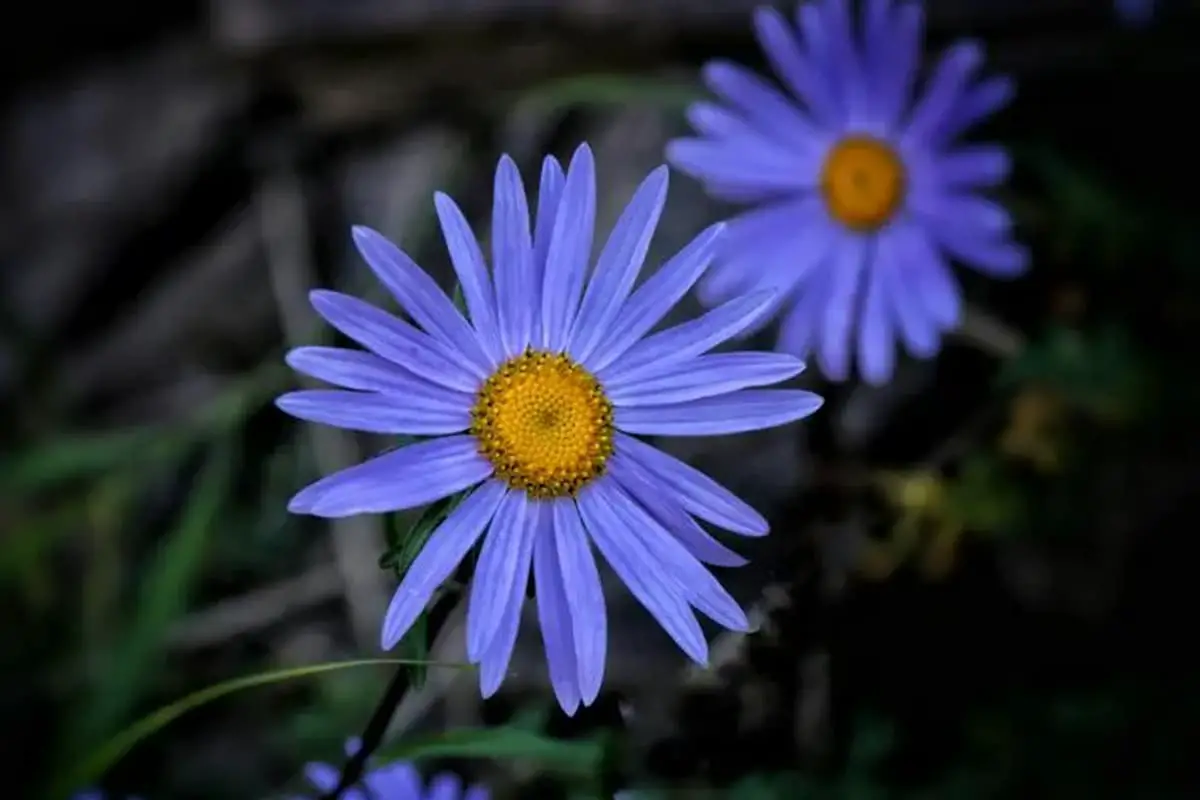
Aster tataricus, a member of the Asteraceae family and Aster genus, is a robust perennial herb native to East Asia. This impressive plant, also known as the Tatarian aster or Tatarinow’s aster, features a strong, erect stem that can reach heights of up to 2 meters (6.5 feet).
The foliage of Aster tataricus is distinctive and changes throughout the growing season. Basal leaves, which are spoon-shaped (spatulate) to elliptic-oblong, typically wither by the time the plant flowers. The lower stem leaves are spatulate-oblong, while the middle stem leaves are oblong to oblong-lanceolate. This progression of leaf shapes contributes to the plant’s architectural interest.
The inflorescence of Aster tataricus is a striking feature, composed of numerous flower heads arranged in large, branching clusters. Each flower head consists of purple to lavender ray florets surrounding yellow disk florets.
The involucral bracts, which encase the flower buds, are linear to linear-lanceolate in shape. The flowering period extends from July to September, followed by fruit production from August to October. The fruits, called achenes, are ovate-oblong and purplish-brown in color.
Aster tataricus has a wide distribution across East Asia, including various regions of China, Korea, Japan, and eastern Siberia. It demonstrates remarkable adaptability to different environments, thriving in a range of habitats from moist, shady slopes and mountain summits to lowland grasslands and swampy areas. The plant typically grows at elevations between 400 to 2,000 meters (1,300 to 6,500 feet) above sea level.
This species prefers a warm, moist climate but exhibits excellent cold hardiness and flood resistance. It grows best in deep, loose, fertile soils rich in organic matter with good drainage. While Aster tataricus is adaptable to various soil types, it struggles in coarse soils and saline-alkaline conditions. Propagation is primarily achieved through division of its rhizomatous root system.
In traditional Chinese medicine, Aster tataricus has been used for centuries. The root, known as “zi wan” in Chinese, is believed to possess expectorant and antitussive properties. It is commonly prescribed to moisten the lungs, transform phlegm, and alleviate coughs. Conditions such as chronic bronchitis, pulmonary abscesses, and certain urinary difficulties are among the traditional indications for its use.
Beyond its medicinal applications, Aster tataricus has gained popularity as an ornamental plant, particularly valued for its late-season blooms. Its tall stature and abundant flowers make it an excellent choice for the back of perennial borders, naturalized areas, and rain gardens. The plant’s ability to thrive in moist conditions also makes it suitable for water-side plantings.
In the language of flowers, Aster tataricus symbolizes wit and intelligence. It is said that those associated with this flower are often articulate, exceptionally clever, and held in high regard by their peers. This symbolism, combined with its aesthetic appeal and adaptability, makes Aster tataricus a meaningful addition to gardens and landscapes.
As with all medicinal plants, it’s important to note that any therapeutic use of Aster tataricus should be under the guidance of a qualified healthcare professional. Additionally, when cultivating this species, gardeners should be aware of its vigorous growth habit and potential to spread through rhizomes, which may require management in some garden settings.
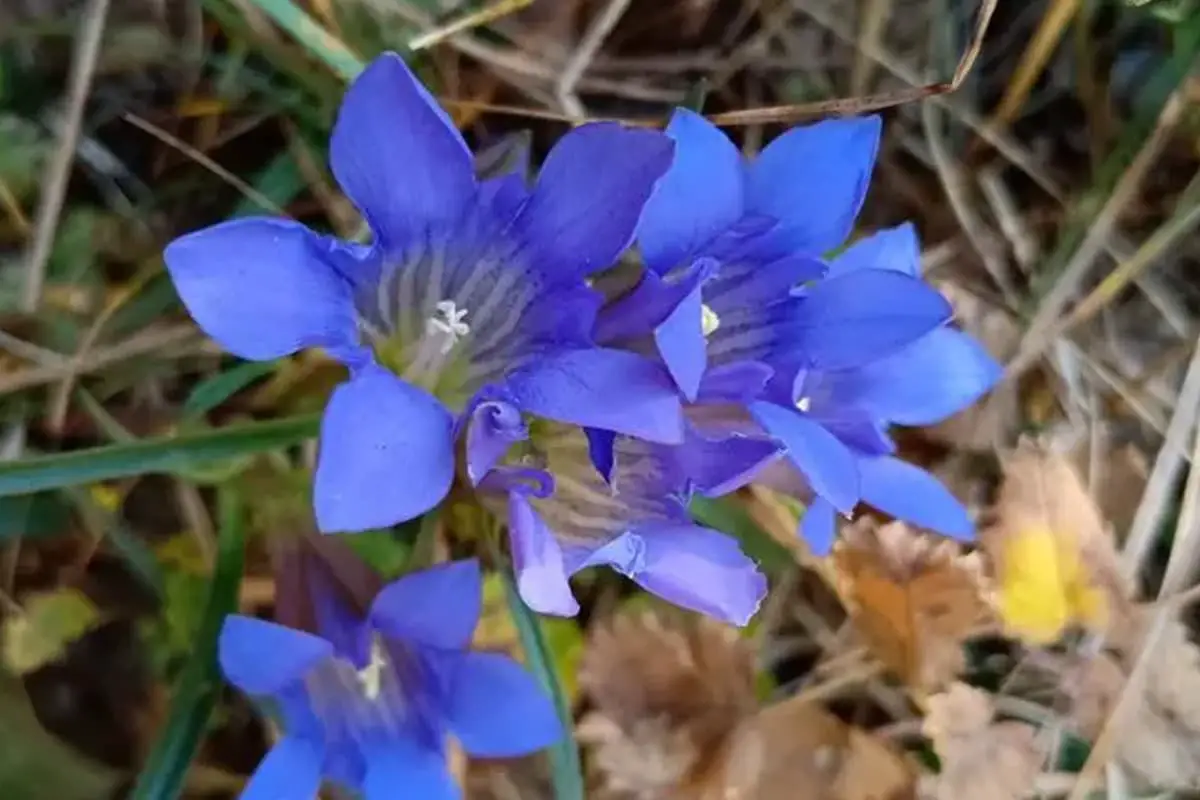
Astragalus dahuricus is a herbaceous legume belonging to the Fabaceae family and the diverse Astragalus genus. This species grows as an annual or biennial plant, characterized by its upright stem adorned with fine ridges and branching structure. The plant exhibits pinnate compound leaves with linear-lanceolate to lanceolate stipules, a typical feature of many Astragalus species.
The leaflets of A. dahuricus are oblong, ovate-oblong, or oblong-elliptical in shape, providing a distinctive appearance to the foliage. The inflorescence is borne on a flower stem (peduncle) that is notably shorter than the leaves, a characteristic that can aid in identification. The calyx is obliquely campanulate (bell-shaped) with linear or bristly sepals, while the corolla displays a striking purple hue and a curved oblong form.
The fruit of A. dahuricus is a linear legume pod with a short stalk, containing reniform (kidney-shaped) seeds that range in color from pale brown to brown. This species has a specific phenology, flowering from July to September and fruiting from August to October, which is important for both its ecological role and potential utilization.
Geographically, Astragalus dahuricus is native to Northeast China, North China, and the Loess Plateau region. Its distribution extends beyond China, encompassing parts of Siberia and Mongolia. The plant demonstrates a preference for sandy soils and can be found growing on slopes, roadsides, and riverbanks. Its ability to thrive in sandy substrates, coupled with its cold and drought resistance, makes it well-adapted to the often harsh conditions of its native range.
In its natural habitat, A. dahuricus is commonly associated with meadow and transformed meadow vegetation communities. This association suggests its potential role in ecosystem dynamics and soil stabilization. Propagation of the species is primarily achieved through seed dispersal or by division of established plants.
Astragalus dahuricus possesses medicinal properties, particularly in its seeds. Traditional uses include nourishing the kidneys and liver and improving vision, although it’s important to note that such applications should be approached with caution and under professional guidance.
From an agricultural perspective, A. dahuricus reaches its peak nutritional value and palatability for livestock during its flowering and fruiting period in summer. This timing is crucial for optimal grazing management.
Beyond its value as forage, the species has potential applications in ecological restoration. It can be utilized for natural grassland reseeding projects and, when mixed with gramineous forage grasses, can contribute to soil improvement through nitrogen fixation, a characteristic common to legumes.
In conclusion, Astragalus dahuricus is a versatile and resilient plant species with ecological, agricultural, and potential medicinal significance. Its adaptability to challenging environments and its multiple uses make it an interesting subject for further research and sustainable utilization in appropriate regions.

Astridia velutina, commonly known as Velvet Astridia, is a succulent shrub belonging to the Aizoaceae family, native to the Richtersveld region of South Africa and southern Namibia. Mature branches develop a gray-brown, woody appearance, while young shoots maintain a pale green color with distinct internodes at branching points.
The leaves are oppositely arranged, crescent-shaped to triangular, and range from pale green to gray-green in color. They possess a narrow, sharp apex that may display a pinkish tinge. The leaf undersides feature a prominent keel-like ridge. Axillary buds are visible in the leaf axils, contributing to the plant’s branching habit.
Astridia velutina produces large, showy flowers at the branch tips, either solitary or in small clusters. The flowers typically have numerous white to pale pink petals and prominent yellow stamens. Flowering occurs primarily in late winter to early spring. The fruit is a fleshy capsule containing multiple seeds, which splits open when mature to release the seeds.
This species is adapted to arid environments, preferring warm, dry, and sunny conditions. It demonstrates excellent drought tolerance but is sensitive to excessive moisture, extreme heat, and intense, direct sunlight. Astridia velutina thrives in well-draining, loose, sandy or gravelly soil that mimics its native habitat.
Propagation is most commonly achieved through stem cuttings, which root readily when placed in a suitable growing medium. Seeds can also be used for propagation, though they may require specific conditions to germinate successfully.
The growth habit of Astridia velutina is sprawling and compact, forming dense mats of foliage that can spread up to 30 cm in diameter. Its unique leaf shape and arrangement give it a distinctive appearance among succulents. While the most common flower color is white to pale pink, some cultivars may produce deeper pink or purplish blooms.
As an ornamental plant, Astridia velutina is well-suited for cultivation in rock gardens, succulent arrangements, or as a potted specimen. When grown in hanging baskets or elevated planters, its trailing branches can create an attractive cascading effect. In cultivation, it’s important to provide adequate drainage and protection from frost, as the plant is not cold-hardy.
To maintain the health and appearance of Astridia velutina, water sparingly, allowing the soil to dry completely between waterings. Provide bright, filtered light or partial shade, especially in hot climates. Fertilize lightly during the growing season with a balanced, low-nitrogen fertilizer formulated for succulents.
With its compact growth, unique foliage, and winter-to-spring blooming period, Astridia velutina offers year-round interest as a low-maintenance, drought-tolerant succulent for both indoor and outdoor cultivation in suitable climates.